Exactly What to Do in Venice (for First Timers)
Before my latest stint in Venice this past spring, I truly believed I would never set foot in Venice again. I had seen Venice twice before that (though it had been roughly a decade, well before the birth of Wheatless Wanderlust), and the whole “overtourism” conversation around Venice had really turned me off on visiting.
However, if you’ve read any of my other Italy guides, you probably already know that the regional diversity in Italy is one of my favorite aspects of the country, and is part of the reason why I’ve returned to Italy in four of the past five years at the time of writing (the other reason is the food, obviously).
There is perhaps no better example of Italy’s regional diversity than Venice, which is a completely different version of Italy than you’d find in Rome, Florence, or even nearby Milan.
So, when I was looking for a place to spend a few nights in the early spring before meeting up with family for a stint in central Italy, I found my attention continuously coming back to Venice.
After doing some reading about Venice’s history and culture (the Venetian Republic was a big player in the Adriatic and eastern Mediterranean for centuries), I eventually decided that a return trip was in order.
And, if we’re being honest, I really enjoyed Venice.
It’s a unique place, shaped by the history and geography – in particular, the lagoon that it was built in – and though it has plenty of problems associated with the fact that they essentially decided to build a floating city in the middle of a lagoon (congestion, pricing out locals in favor of tourists, rising water levels, etc), walking the canals in the early morning is a truly remarkable experience.
For the record, the location of Venice is ridiculous, and the first thing I thought when I saw the city from the waterbus on the way from the airport is “whose bright idea was it to build a city here?” (Spoiler: It was the residents of inland northern Italy who had enough of the Germanic tribes coming down and raiding their cities).
In this guide to what to do in Venice, we’re not going to give you a list of every single museum, park, piazza, and church that you could possibly see in Venice.
Instead, we’ll give you a blend of the main attractions in Venice – what they are, some brief historical context, and how to see them – but we’ll also give you some of our other favorite things to do in Venice.
Which, to be honest, is mostly eating and drinking, with a few magnificent views for good measure.
Armed with that (and our guide to planning a Venice itinerary), you’ll be ready to plan a trip that will go a level deeper than most and learn about the different aspects of Venice’s complex history as a power in the Mediterranean that shaped the city as we know it today.
Learning is our favorite part of travel, which you’ll probably realize as you read this.
Sound good to you? Let’s get into it.
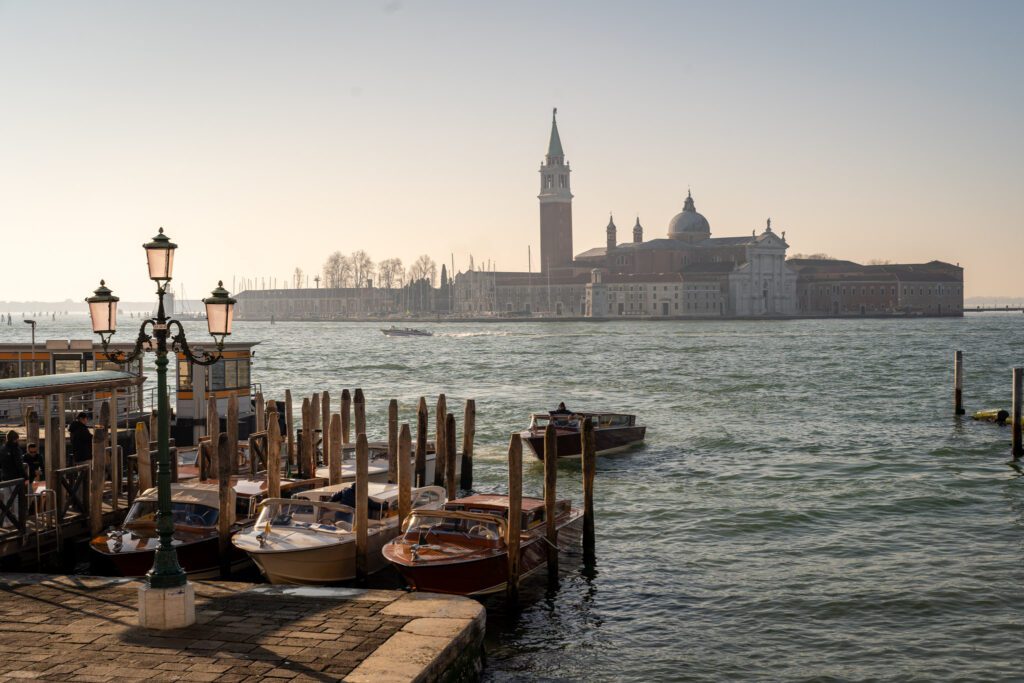
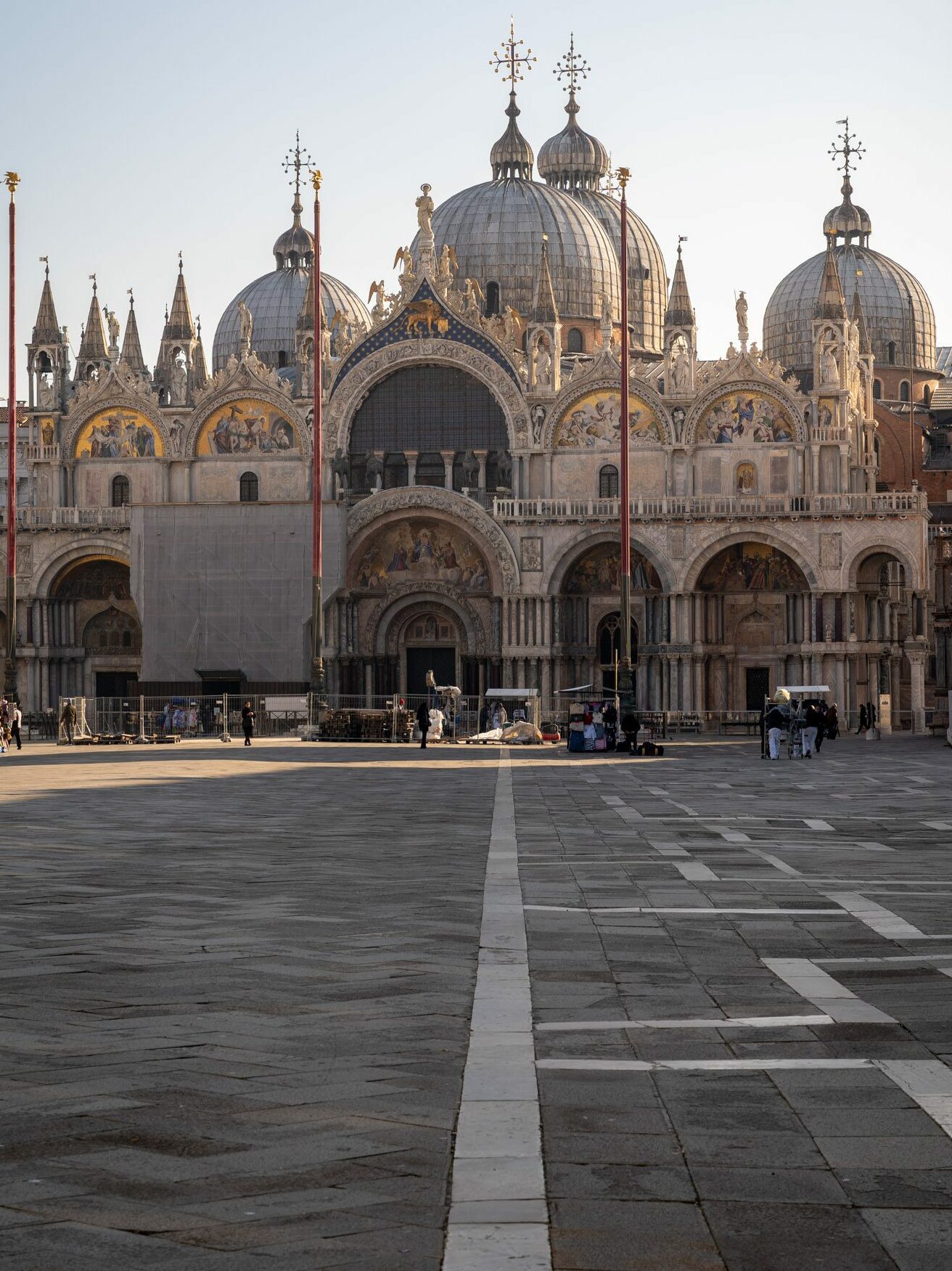
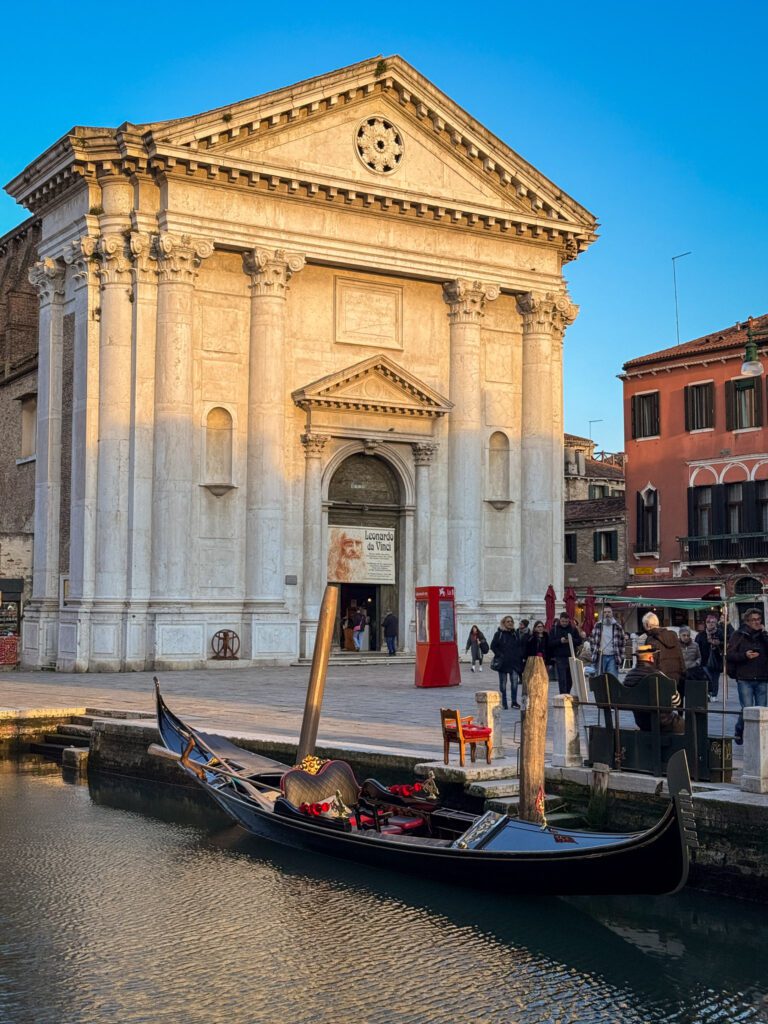
Disclaimer: Some of the links in this post, like hotel links, are affiliate links, meaning at no additional cost to you, we make a little bit of money if you click through and book. That being said, we would never recommend something to you that we don’t stand behind 100%.
What to Do in Venice: A Complete Guide for First Timers
Let’s get right into it – below, you’ll find our favorite things to do broken up into three sections to make it easy to follow.
Those three sections are:
- The Main Sights in Venice
- Other Things in Venice That We Love
- Things to Do for Foodies in Venice
Obviously, some things will take more time than others (e.g. the Doge’s Palace vs. enjoying a canalside spritz), so take the order with a grain of salt.
One other thing to know is that we go into detail on why we believe each thing deserves a spot on the list, and all the practical information you need to actually do it like how much it costs and how to get tickets.
We get really frustrated when we read things, and there’s no actual details that help us plan our trip.
To that point, if there’s something missing or something has changed, please please please let us know so we can fix it!
The last thing I want to touch on is the fact that, in my mind, Venice is almost three different cities in one, and which version of the city you experience is going to have a huge impact on the way you perceive your time in Venice.
The first city is the area between Rialto Bridge and Piazza San Marco between 10am and 7pm, which is full of narrow streets packed wall to wall with people (with various levels of spatial and situational awareness) and stores selling either souvenirs or designer bags (without much in between).
The second city within Venice is that same area, but outside of those peak hours when it is calm, relatively quiet, uber romantic, and gorgeous.
I HIGHLY, HIGHLY recommend visiting Piazza San Marco early in the morning (before 9am) to have the place mostly to yourself. You’ll see why if you return during the heat of the day, when it’s crowded and far less majestic.
The third and final version of Venice is the one that you find when you venture off of the “train station – Rialto Bridge – Piazza San Marco” path that the vast majority of tourists focus on.
Wandering around the backstreets of Cannaregio at lunchtime, I was struck by the fact that I had ventured just a block or two off of the main drag (Strada Nova, in this case) and yet I would go several blocks without seeing a trace of another human soul.
It made me realize just how concentrated the crowds really are between Piazza San Marco and the Rialto Bridge – which is where I spent the vast majority of my time on my previous trips to Venice – and what a shame it is that it seems most people just completely miss the rest of the city.
Which is significantly more enjoyable and full of local flair (something that is becoming more rare in Venice and cities like it by the day, it seems), like wine shops that sell wine by the liter (bring your own bottle) out of big stainless steel containers.
Wandering around Cannaregio and Dorsodouro just before sunset and enjoying a spritz in a plastic cup (Select is the local choice when it comes to alcohol, Aperol is for tourists apparently) and snacking on cicchetti is, arguably, in the must-do category.
If I only had the budget for one tour in Venice (and I could eat gluten, which is a big factor in the fact that I rarely get to do food tours), I would strongly consider doing a food tour that focused on cicchetti in one of those neighborhoods (like this one).
I also realized that I would absolutely never recommend staying in that area between San Marco and Rialto, which you can read more about (and where to stay instead) in my guide to where to stay in Venice.
The Main Sights in Venice
Look, we get it. When you visit Venice for the first time, you’re definitely going to want to see the main sights that everyone talks about – the sights at Piazza San Marco (the Basilica di San Marco and the Doge’s Palace) and the canals.
The thing we want to make super duper clear is that we think that shouldn’t be the only thing you do while you’re in Venice.
We also think it’s important to consider how you want to experience each of the main sights.
Which is why we have detailed guides below that include our recommendations on how best to tackle each sight to get the most from the experience.
Whatever you do, make sure to save time for the other stuff – the food, the views, soaking up the atmosphere, and some good old fashioned wandering – in between these main sights.
St. Mark’s Basilica (Basilica di San Marco)
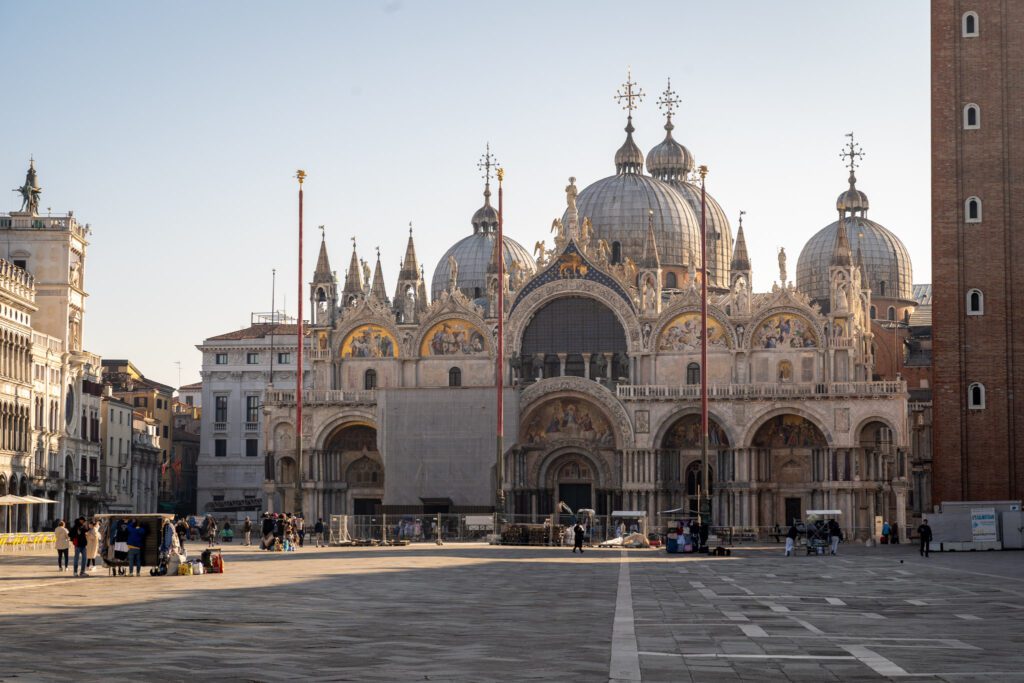
On the same recent trip that brought me back to Venice for the first time in almost a decade, I also spent time in Rome and Florence and got to see St. Peter’s Basilica and the Duomo di Firenze along with the Basilica di San Marco in Venice, which are all magnificent pieces of art and architecture.
Of the three, the Basilica di San Marco in Venice was my favorite. Part of that is probably how I experienced it (I did this after hours tour of the basilica and the Doge’s Palace, which I can’t recommend more highly), but the other piece is the interior decoration, which took several centuries to complete.
As soon as I turned a corner and saw the marble covering the side of the cathedral, I let out an audible “whoa.”
It was early in the morning, before 7am, and I had the Piazza di San Marco almost to myself (I highly recommend going as early as you can just to wander around the piazza and marvel at the architecture, then return later in the trip to actually visit the sights).
As soon as you see the golden mosaics covering every inch of the ceiling and domes of the church, you’ll understand why this was my favorite.
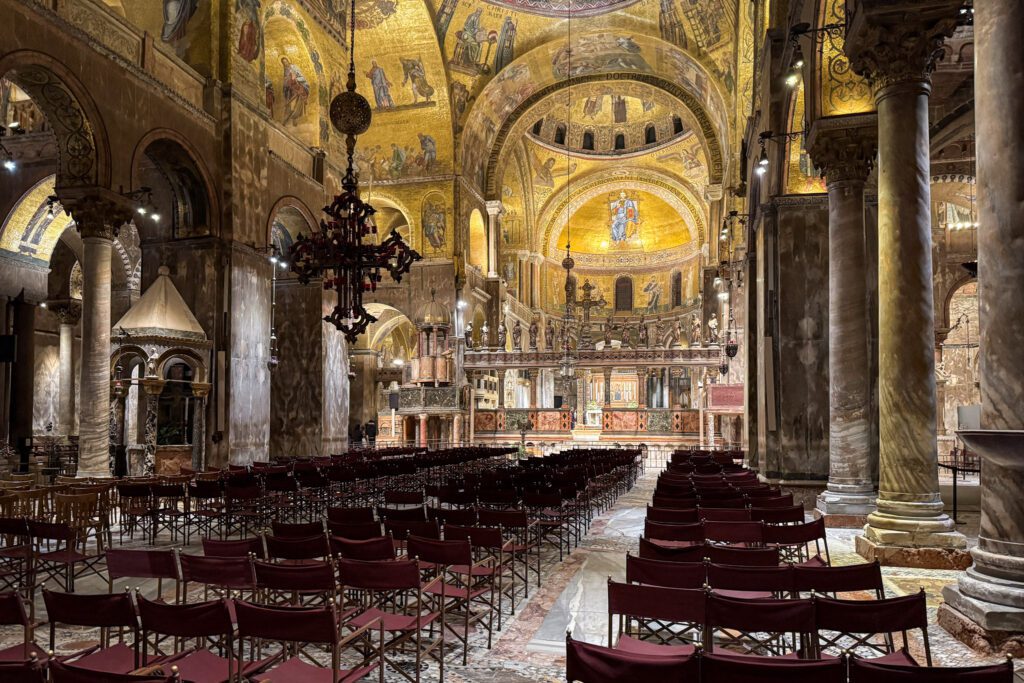
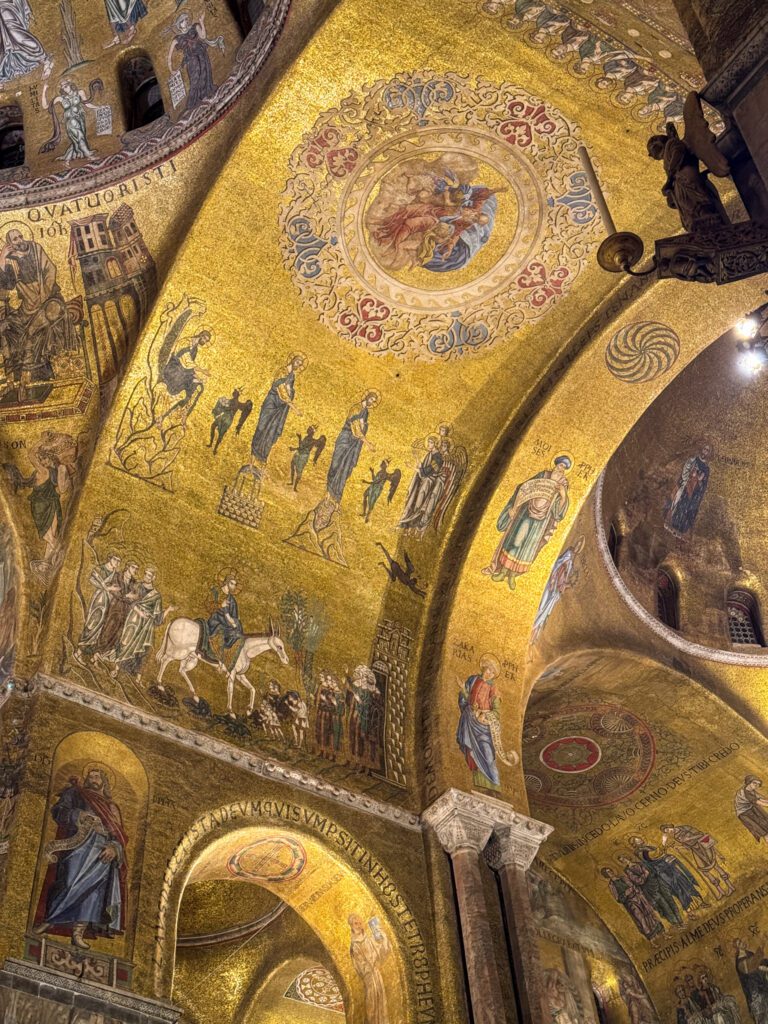
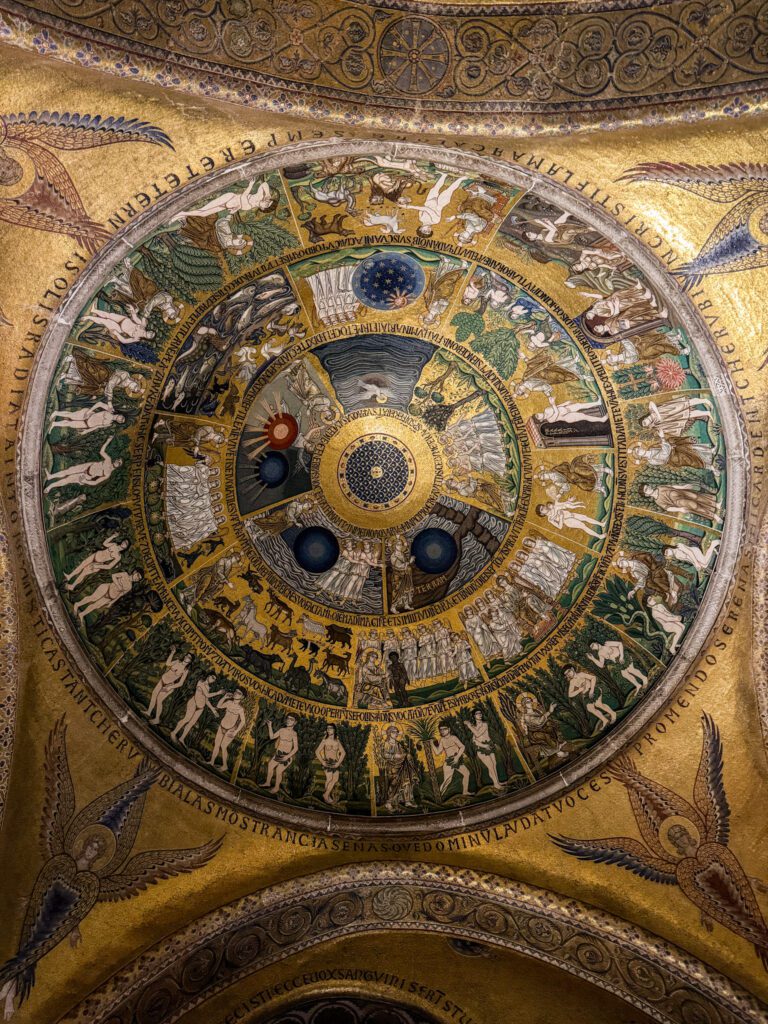
Imagine the hours that went into cutting and placing each individual piece of the gorgeous mosaics. It’s wild.
The whole thing is a bit of a mashup of different architectural styles, mostly because it took them roughly six hundred years to complete the decoration (though the brick structure that you can still see traces of under the slabs of marble was built in about 30 years).
The church as we know it today was built starting in the 11th Century, and the design is based on the Church of the Holy Apostles that stood in Constantinople (it has since been destroyed, leaving St. Mark’s as an important piece of architectural history).
The story of this basilica – and the establishment of Venice as a major player on the Italian peninsula and in the Adriatic Sea – is, quite frankly, hilarious to me. It’s every bit as salacious and worthy of an HBO show as the history of the Medici in Florence.
Though, in Venice’s case, it could just as easily be a slapstick comedy rather than a drama.
Here’s the high-level story of how the Basilica di San Marco came to be.
After relocating to the lagoon to escape the Germanic tribes making more frequent incursions on the mainland, the merchants who called what we now know as Venice home were looking to establish themselves as a center of power.
Which, of course, means that they needed their own religious institutions. In order to have a basilica, though, you needed to have a religious relic of an acceptable level (whatever that means).
Venice had all the wealth and resources to build a basilica, but what they didn’t have was a relic to get it consecrated.
So what did they do? They stole one.
They went down to Egypt, which was now under Muslim rule, and stole the body of Saint Mark from Alexandria and brought it back to Venice.
Which is certainly not the last time you’ll see Venice, uh, “repossess” artifacts from the Muslim world to display at St. Mark’s.
Much of the wealth inside the cathedral came from Venice’s participation in the Crusades, which allowed them to once again steal valuable stuff to increase their own power and influence.
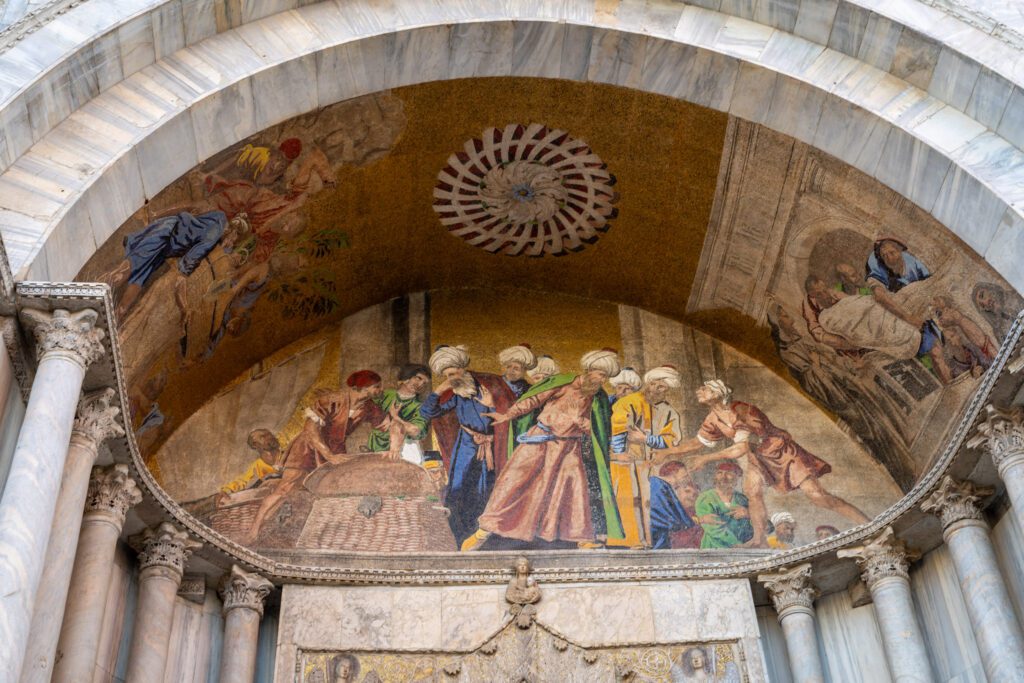
Visiting Independently
Unlike, say, St. Peter’s Basilica in Rome, you do need to pay to enter the Basilica di San Marco now.
It costs €3 to enter the basilica, and there are two ways to get tickets: booking online in advance or waiting in the (usually long) ticket lines on the day of.
As one of the two most popular sights in Venice, it’s definitely worth booking in advance through the Basilica’s official ticket office to avoid the long lines at the ticket office on the day of (an easy way to save an hour or two of your precious vacation time).
However, it is worth noting that pre-booking your tickets does cost an extra €3, bringing the total cost to €6 per person.
Similar to the Duomo in Florence, there are several pieces of the complex that you can choose from when you’re planning your visit.
They are the Basilica itself, the Pala d’Oro, the Loggia di Cavalli (the Horse Lodge, which is also the Museum), and the Campanile (the bell tower).
The site offers a variety of combinations of the above aspects, but we’d say there are only two pieces to focus on; the basilica and the Loggia di Cavalli OR the bell tower, which has some nice views out over St. Mark’s Square and the Venetian Lagoon.
I (Matt here) did an after hours guided tour of the basilica (highly recommended) that included the Pala d’Oro and, while it was kind of cool to see all that gold work up close, I don’t think it’s worth it for most people.
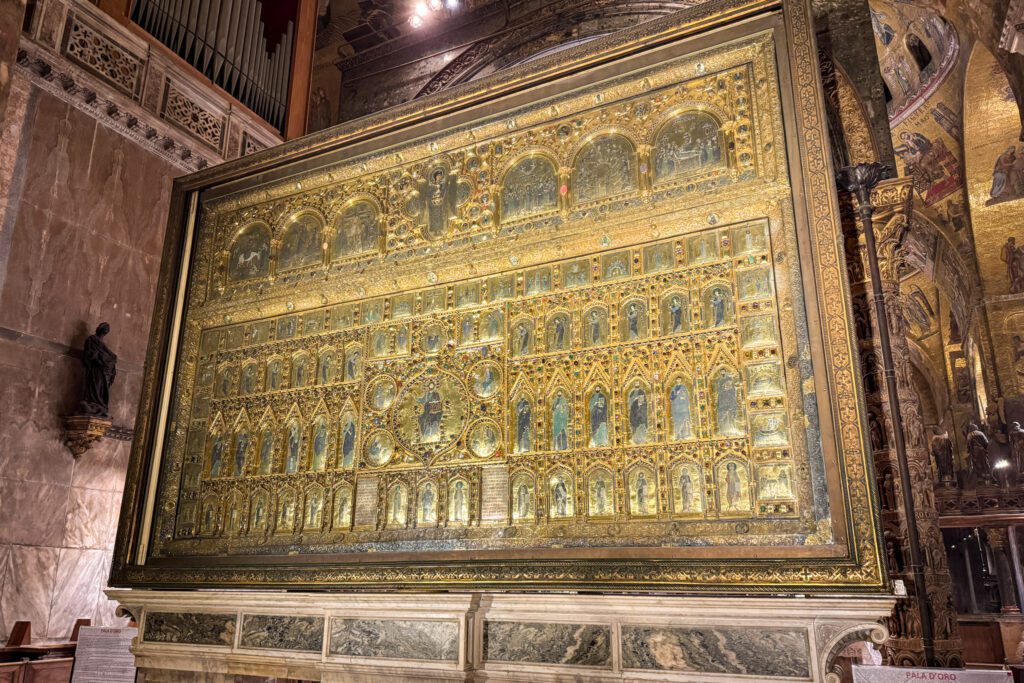
As for the bell tower, it’s a great view out over the city and the lagoon, but I don’t know if it’s really worth the €12 IF you’ve already seen the view of Piazza San Marco from the Loggia di Cavalli (which is the terrace of the basilica where you’ll find the original versions of the horses that sit above the doors of the basilica).
And if you have limited time, we’d just focus on the Basilica and Loggia di Cavalli and spend the rest of your time elsewhere (ideally far away from Piazza San Marco, which is the most crowded part of Venice).
When you look at the official ticketing site, you’ll notice that you have a bunch of choices in terms of combinations of the various pieces of the complex.
If you’re taking our advice and skipping the Pala d’Oro and seeing the Basilica and the Loggia di Cavalli, you’ll want the ticket called “Basilica S.Marco + Museum 15€” (which is a little confusing).
There’s also an option that includes the Pala d’Oro, which is called “Basilica S.Marco + Pala d’Oro + Museum Loggia Cavalli 20€” which is the ticket you’d book if you want to see the Pala d’Oro too.
You’ll choose an entry time, which means you’re not going to be as flexible, but you also won’t have to wait in the LONG lines at the ticket offices on the day of your visit.
One other note here – I have used Rick Steves’ free audio tours as a substitute for paying extra for an audio guide or a guided tour, and generally think they’re pretty good (especially considering the fact that they’re free).
He has one for the basilica, and the easiest way to access it is to download his app (called Rick Steves Audio Europe) and download the guides you want in advance, that way you can access them if you don’t have internet access.
The Doge’s Palace (Palazzo Ducale)
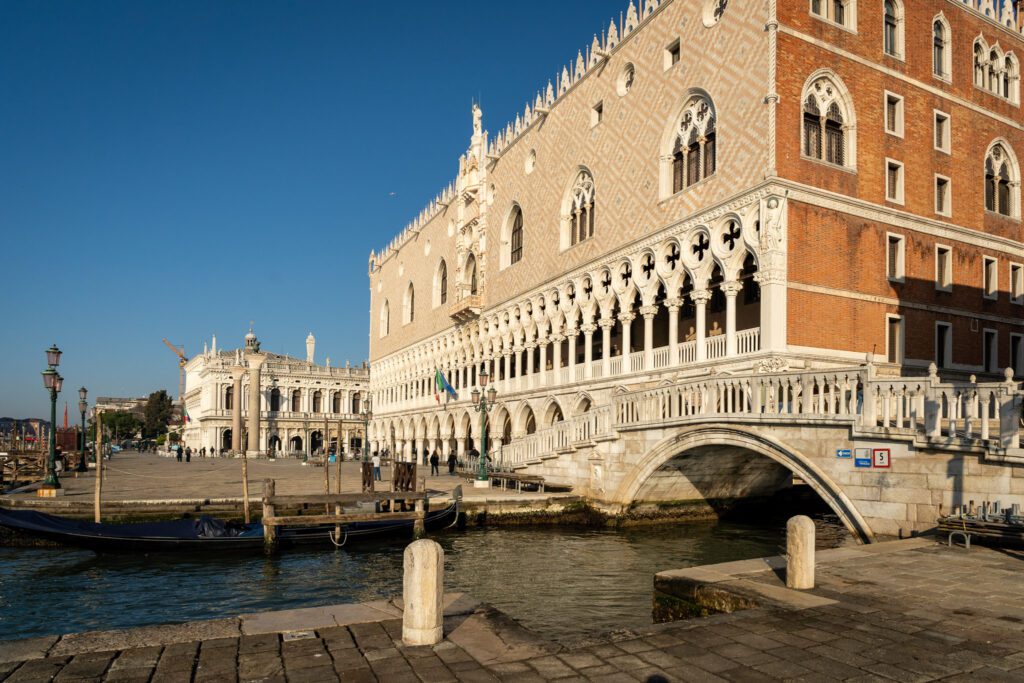
The Doge’s Palace (Palazzo Ducale in Italian) makes up the other half of the political and religious power center that is the area around Piazza San Marco (with the economic center being closer to Rialto Bridge along the Grand Canal).
In our humble opinions, if you’re either short on time or short on energy and only want to do one of the big attractions on Piazza San Marco, we would pick the basilica (and it’s not particularly close).
After all, the best parts of Venice to us are far away from Piazza San Marco, and we can totally see the argument for choosing between the basilica and palazzo with limited time.
Especially if you’re all “palace-d and church-d” out after spending time in other Italian cities.
I did it on my recent trip, and found it interesting, but I’m not sure I would feel the same way without the guided tour I was on (the after hours tour I mentioned previously, which includes both the Doge’s Palace and Basilica).
The interior is a lot of beautiful art with religious themes and ridiculous over-the-top gold accents, which is obviously beautiful, but is not particularly unique.
What is interesting and unique is the political aspects of the Venetian Republic. And the Doge’s Palace is the proverbial “room where it happens” of that realm.
So, all that being said about skipping it, if you’re willing to invest the time and energy into understanding the political landscape that existed when Venice was a major power in the region, the Palazzo Ducale is pretty interesting.
And the Senate chamber alone rivals the interior of St. Mark’s Basilica in a way, with its storytelling frescoes, high ceilings, and sequential portraits of all of the doges.
It does take a little bit more peeling back of the layers of the onion to get your mind around it.
The first thing to know about the Doge’s Palace is that it’s sort of like the White House and Congress combined.
It’s part residence for the Doge (who is for all intents and purposes something like a duke or mayor) and part government offices.
There’s also a prison aspect, with the original building serving as a jail for centuries before they outgrew it and built a new jail in the building adjacent to the palace to the east – the one that is connected via the Bridge of Sighs.
The second thing to keep in mind is that it has changed significantly over the years.
That’s partially due to expansion with the needs of Venice and its growing empire necessitating larger buildings, partially due to the fact that it has burnt down and been rebuilt several times over its history, getting grander and more opulent with each subsequent effort to rebuild.
The interior is incredibly ornate, especially in the senate and council chambers, with dark wood, plenty of gold, and the trademark colorful frescoes that you’ll find all over Venice (the Venetian painters LOVE their bright colors and textured fabrics) painted by legends like Tintoretto and Titian.
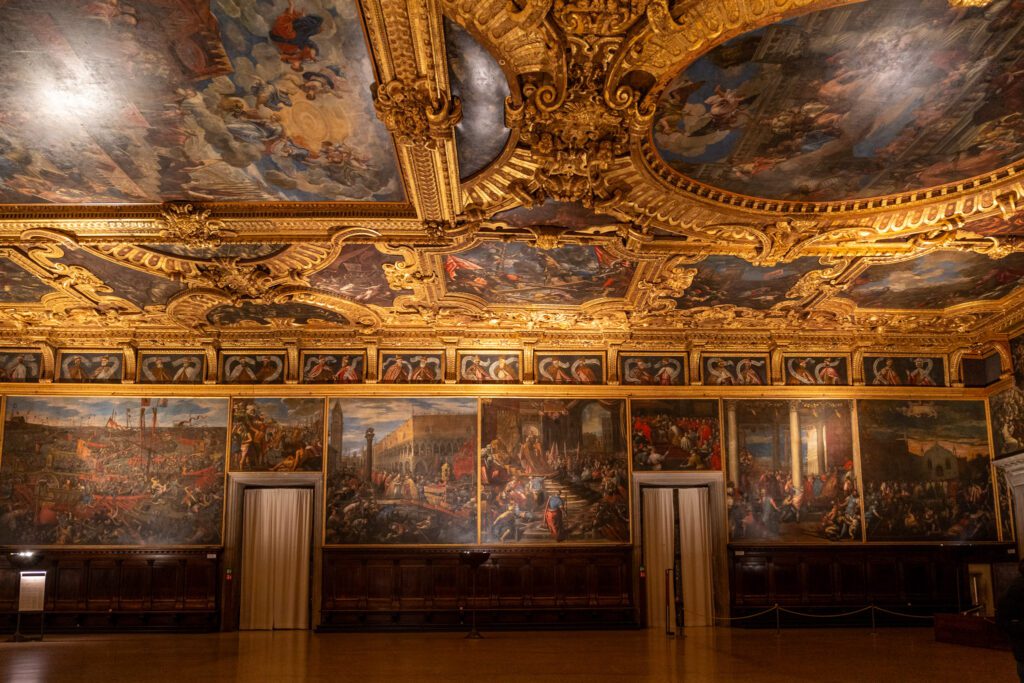
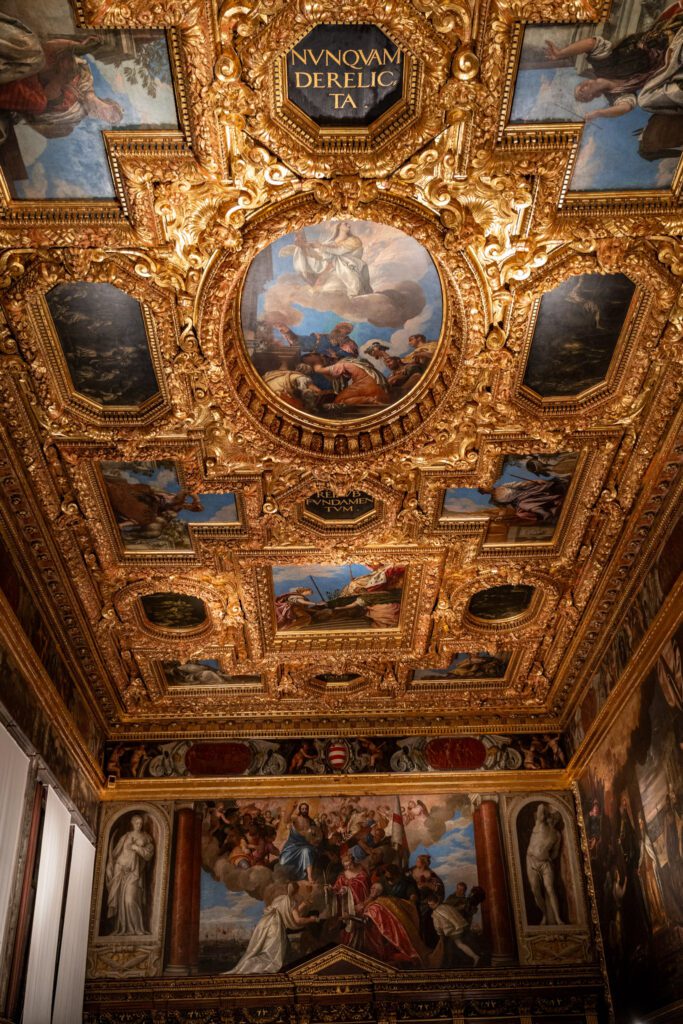
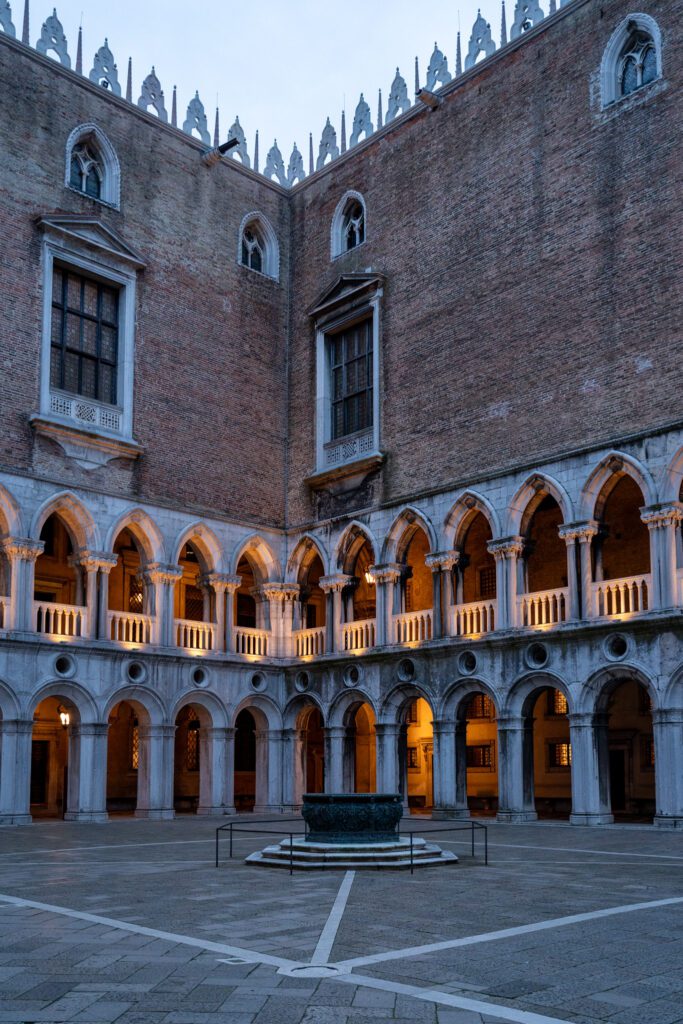
Visiting Independently
If you want to visit the Doge’s Palace on your own, you’re definitely going to want to buy tickets in advance. Especially because the ticket price is €5 cheaper if you book more than a month in advance (€25 if you buy more than 30 days in advance, €30 if you buy within 30 days).
The official website for the Palazzo Ducale is here, and you can buy tickets directly through them.
The other thing to know is that the public opening hours on Friday and Saturday are extended to 11pm between May 1st and the end of September (basically, peak season) and it is generally much less crowded in the evening hours.
If you’re looking for a way to see the palace without all the crowds you’ll encounter during the day, that’s a good option.
As I was planning my own trip, I also realized that they have some nice resources on that site (specifically on this page – the downloads at the bottom) with good history and context that would be worth looking at before you visit.
Worth noting that your ticket is good for entry to the other museums on Piazza San Marco – the Museo Correr, Museo Archeologico Nazionale, and Monumental Rooms of the Biblioteca Nazionale Marciana – over the course of three days.
There are some additional experiences that you can book through the official website that are worth considering, though we’d really only recommend one of them.
The extra that we’d recommend is the “Secret Itineraries” tour, which includes a guided tour that covers the history and governmental institutions of the Venetian Republic.
It’s just a few Euros more than the entry ticket, and is a great option if you want to gain more insight into Venice’s history and culture without paying the premium for a guided tour through a private company.
Explore the Canals
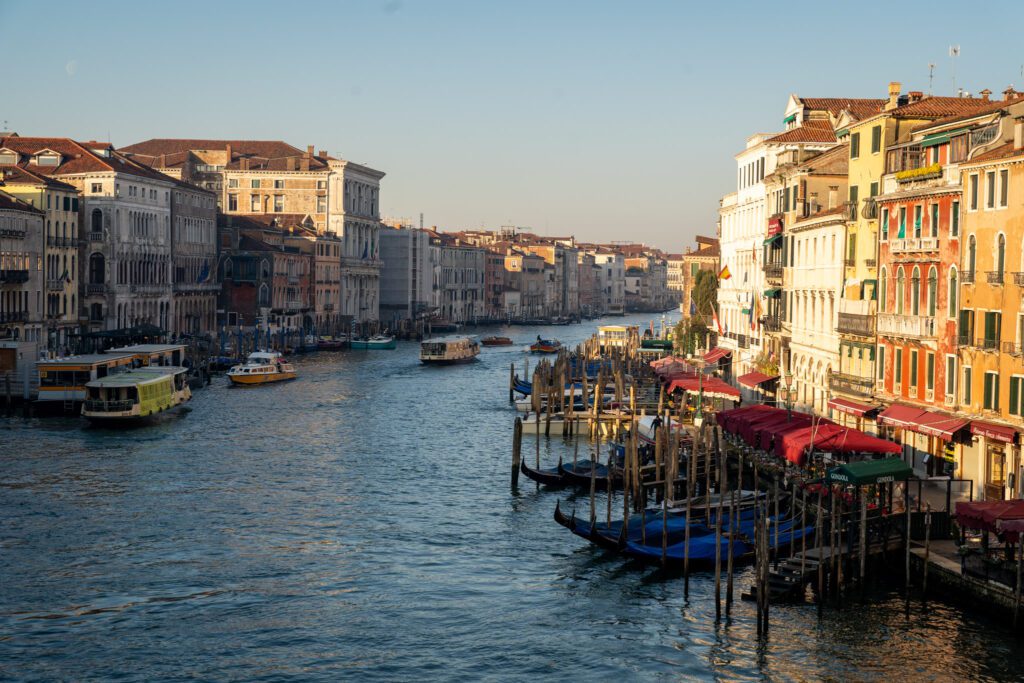
I’ll be honest, I wasn’t a huge fan of taking boat rides until I took an early morning canal cruise in Amsterdam last year, which offered a novel way of seeing a city for which canals are such a big piece of its history and culture.
Venice’s maritime history and heritage means that, like Amsterdam, seeing the city from the water offers a unique (not to mention beautiful) perspective.
There are two specific ways to get out on the water in Venice; the iconic (but expensive) gondola rides – which you can do as either a private experience or a shared experience, and the more economical vaporetto (the ferries that serve as public transportation in Venice).
Option 1: Using the Vaporetto to See the Canals
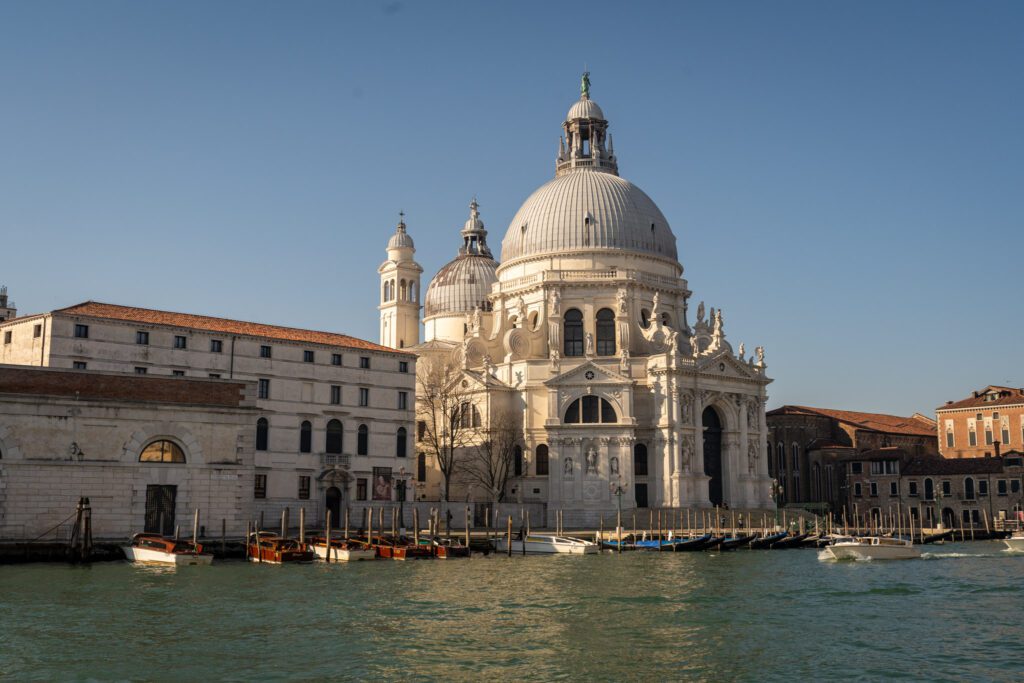
Regardless of whether or not you end up using the vaporetto in this particular way, you’ll probably ride it at least once during your time in Venice.
It’s the only form of public transportation in the city, and the only alternative to cover larger distances (other than expensive private water taxis) is walking.
You can put together a nice little tour-de-canals by stringing together a ride on two of Venice’s vaporetto routes.
However, it is worth noting that, for obvious reasons, the vaporetto do stick to the big canals, which means you’re missing seeing the inner rings of canals, which tend to be quieter and more charming, from the water if you choose this option.
First, here is the official website of the vaporetto for information on routes and pricing. Here’s a useful map of the routes that you can use to plan your trip.
You can buy your ticket at the self-serve machines on the platform (you can toggle the language to English to make it easier), or at the window with a person (though the lines will be longer for that).
As long as you complete the rides within 75 minutes, you only need one ticket (which is €9.50 at the time of writing). Make sure to validate your ticket as you board the boat.
In terms of the routes we’d recommend, the absolute must-do is route 1 from the train station to Piazza San Marco, which traverses the Grand Canal, passing under Rialto Bridge on its way to San Marco. It’s also the busiest route, so lines can be long.
The next question you need to answer is whether or not that one ride is enough for you. It will take an hour, one way.
If that’s enough for you, we’d take it from Stazione Santa Lucia (the main train station) to Giardini “B”, which is just past San Marco, and walk back from there.
If you’re craving more, we’d take route 1 all the way to the end of the line (Lido) and then hop on either route 5.1 (which takes you around the north end of the city) to Fondamente Nova, or route 5.2 (which retraces your steps a bit, but then takes you along the southern end of the islands to the southern end of Dorsoduro) to Zattere.
If you add the second route, you’re going to need multiple tickets for this ride, and we’d buy and validate one for each ride to avoid fines.
This is a good budget option for seeing Venice from the water, though you are definitely making some concessions in terms of just how much of the more romantic part of the canals you’re seeing because of the nature of the water buses.
Option 2: A Private Gondola Ride
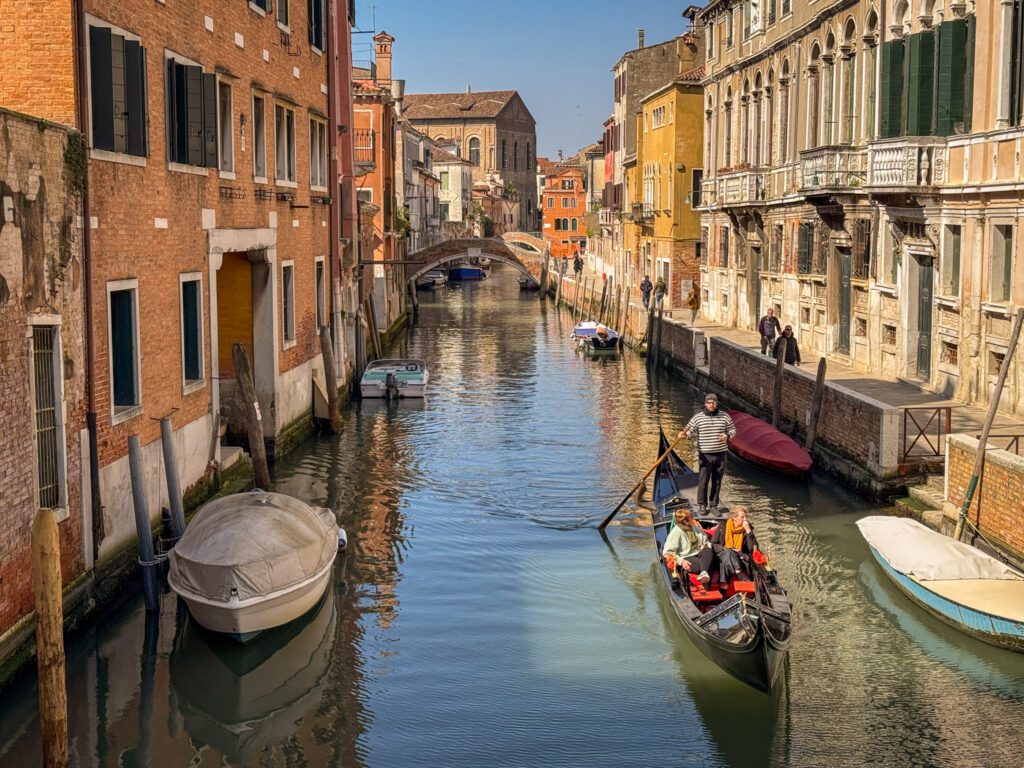
If part of your Venice vision includes a romantic gondola ride that can take you to some of the smaller canals and see parts of the city from the water that most tourists miss, then a private gondola ride is probably the better option.
I’ve had a few people ask me some version of “is a gondola ride worth it,” and while it’s a fairly personal question because it depends on what you value and your budget.
I do think it’s worth keeping in mind that Venice is one of a handful of cities in the world built around a network of canals, and seeing the city from the water is a must-do because of that.
In my opinion, the question is whether or not roughly €100 is worth it for having an experience that you’re unlikely to find anywhere else in the world.
For some, the answer is no (and I’d point you towards the vaporetto option above for a more cost-effective version).
For others, the answer is yes, and that’s who this particular section is for.
There are a few important things to know here.
First, there is no need to pre-book. The price of a gondola ride is regulated throughout the city and, at the time of writing, a daytime gondola ride (9am to around 7pm) is set at €90 for a 30 minute ride, while an evening gondola ride is priced at €110 (for a 35 minute ride).
To book a boat, you simply find one of the many gondola stands along the city’s canals, talk to the gondoliers, go on the ride (agree to the price before you get on the boat and make sure it’s the price we just went through), and give them the fare for the ride at the end.
DO NOT PAY MORE THAN THE PRICES ABOVE. It’s a regulated price, and it is illegal to charge more for the specific durations and times of day we just covered.
Second, that price is per boat (usually a max of five people per boat), not per person, and this is going to be what you might call a “private” gondola, meaning you and your companions are the only ones in the boat (with the gondolier, of course).
Third, there is no expectation of a tip at the end of the ride. Though if you feel like you had an amazing experience, there’s also no rule that says you can’t tip your gondolier for their work.
The last thing I’d consider is where you take the gondola from. Personally, I’d avoid taking one from anywhere near Rialto Bridge or the Piazza San Marco, and instead find one in San Polo, Dorsoduro, or Cannaregio.
The reason? There are really two.
By starting in one of those less-traveled parts of the city, you’ll get to see quieter side canals that most people aren’t ever going to visit. A good example is this stand in Cannaregio.
The other reason is that you’re far more likely to have a worse experience or get scammed when you’re closer to those big tourist magnets.
If you don’t care so much that the boat is specifically a gondola, a shared boat ride might be a more efficient option to see the canals from the water.
The other benefit of this option is that you’re going to get a longer ride (usually around 90 minutes) – which allows you to cover more ground – and you’re going to get a more cohesive story that will teach you something about Venice’s layout, culture, and history.
Personally, this would be my choice between the two organized options (the other being the private gondola), but that should check out if you’ve spent any time at all in this corner of the internet.
Here are three options that I came across that I saved (though the timing didn’t work out on any of them for my recent trip because I was there in low season).
All of them are a 90 minute ride, and have slightly different focuses and starting points.
Personally, this would be my choice between the two organized options (the other being the private gondola), but that should check out if you’ve spent any time at all in this corner of the internet.
Keep in mind that the prices you see are for a boat ride that is three times longer than the private gondolas, which explains the price premium.
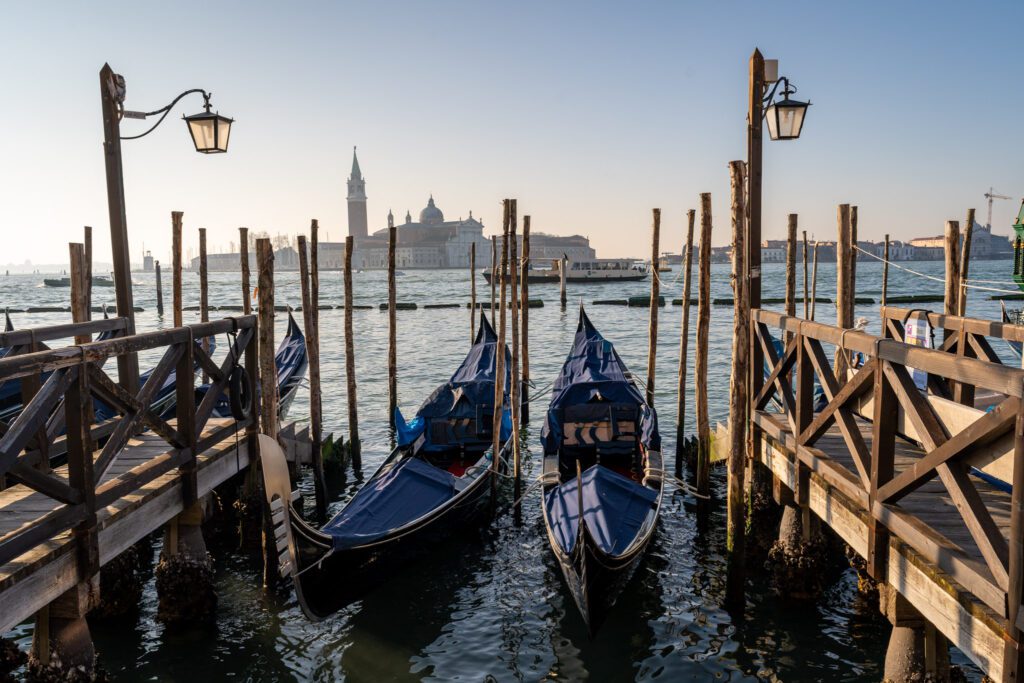
Other Things in Venice That We Love
Of course, those three “main” attractions aren’t the only things you should spend your time on in Venice.
In fact, I’d strongly recommend that you spend most of your time as far away as you possibly can from Piazza San Marco and the Rialto Bridge, as that’s by far the most crowded part of the city (and, particularly at peak times and in peak season, the least enjoyable).
Wander Venice’s Other Neighborhoods
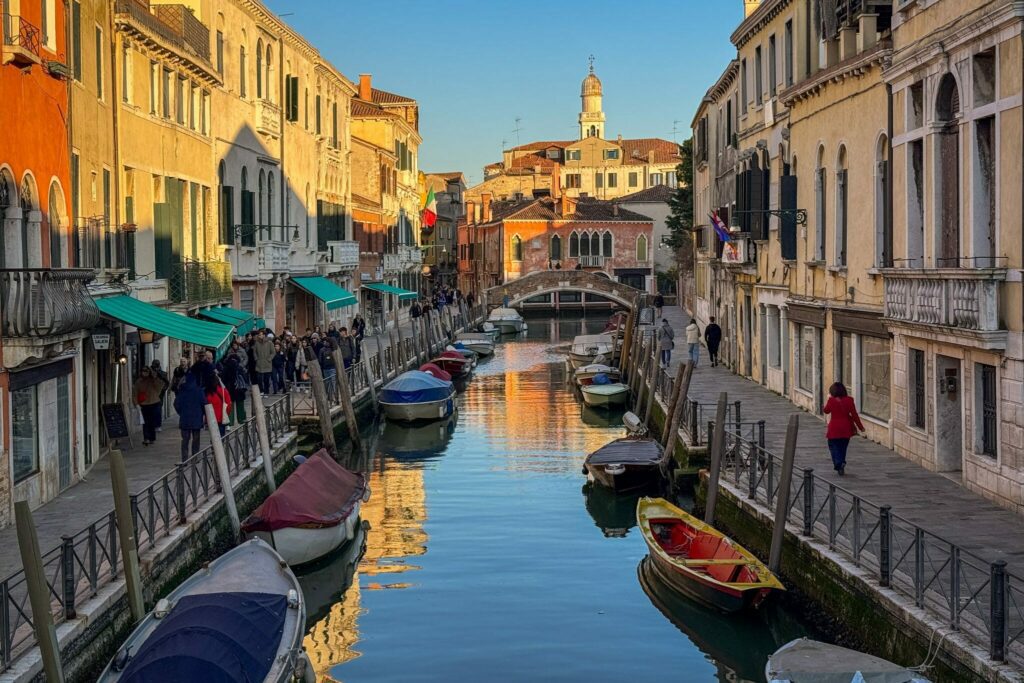
90% of tourists spend all of their time in the corridor that leads from the train station to Rialto Bridge to Piazza San Marco, never straying from that well-worn path.
It’s no wonder that people view Venice as crowded and inauthentic!
I had multiple experiences throughout my few days in Venice on this most recent trip where I found myself in Venice’s other neighborhoods walking several blocks, crossing canals, and not seeing another soul.
All it took was wandering a few blocks off of the main street in the area to find that peace and quiet.
Venice is broken up into six sestieri (which can be roughly translated to “districts”), and the vast majority of people spend their time exclusively in San Marco.
Of the six, there are three that I found myself drawn to, and they form a spine down the center of the city.
They are Cannaregio (the northern end of the city), San Polo (the eye of the storm in the center of the city), and Dorsoduro (the southern end of the city).
Here are mini guides to each of these neighborhoods to give you a starting point for exploring them.
Exploring San Polo (Rialto Bridge + Rialto Market)
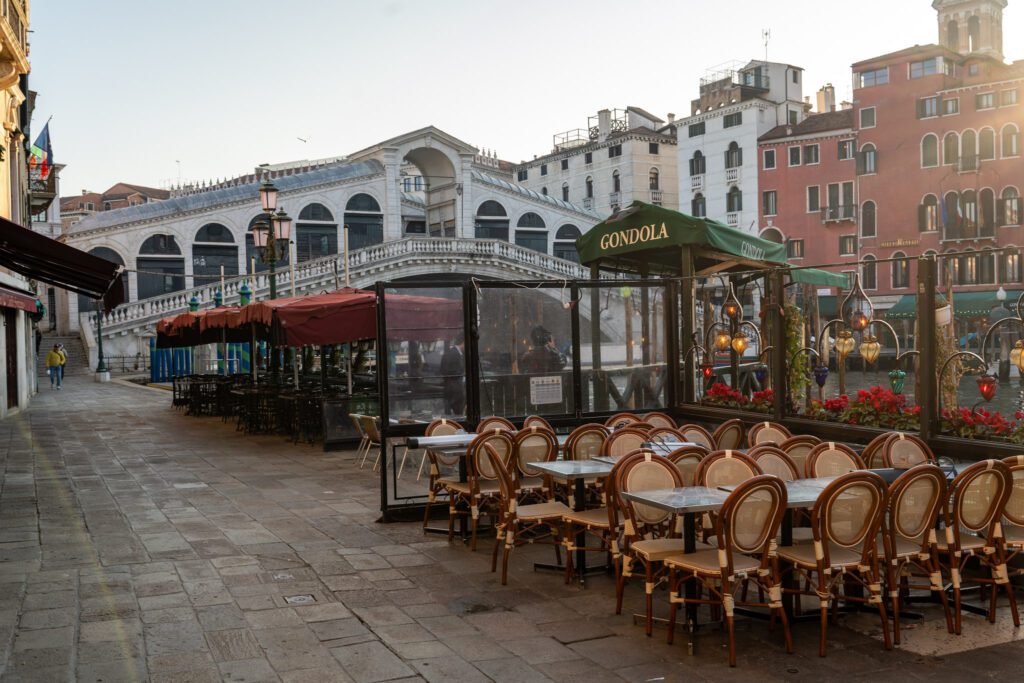
When it comes to the six sestieri of Venice, San Polo is the eye of the storm, while the other five radiate around it.
This is where I stayed, and it’s a nice mix of main sights like Rialto Bridge and Mercato Rialto, and quieter alleys and canals.
Make your way through San Marco to the world-famous Rialto Bridge.
Ideally, you’re here early enough to admire the bridge in all its glory without the hundreds of people milling around it.
This bridge is the oldest bridge in Venice that crosses over the Grand Canal (there are only four of them), and has been the center of economic activity in the city for centuries.
Originally, it was a wooden bridge, but that version of the bridge either collapsed or caught on fire several times before they decided to use stone instead, and that’s what you see here today.
There are excellent views in both directions, but we like the view down the Grand Canal to the southwest best (and it’s also the part of the bridge that gets the most packed).
Cross the bridge from San Marco into San Polo and follow the street straight ahead, where you’ll find yourself at the Mercato di Rialto.
The open-air market (ish, it is technically covered) is full of fresh vegetables – including multiple different varieties of artichokes grown in the lagoon in the spring – and fresh fish.
It’s at its best in the morning, which is why we have you here at this particular time of day.
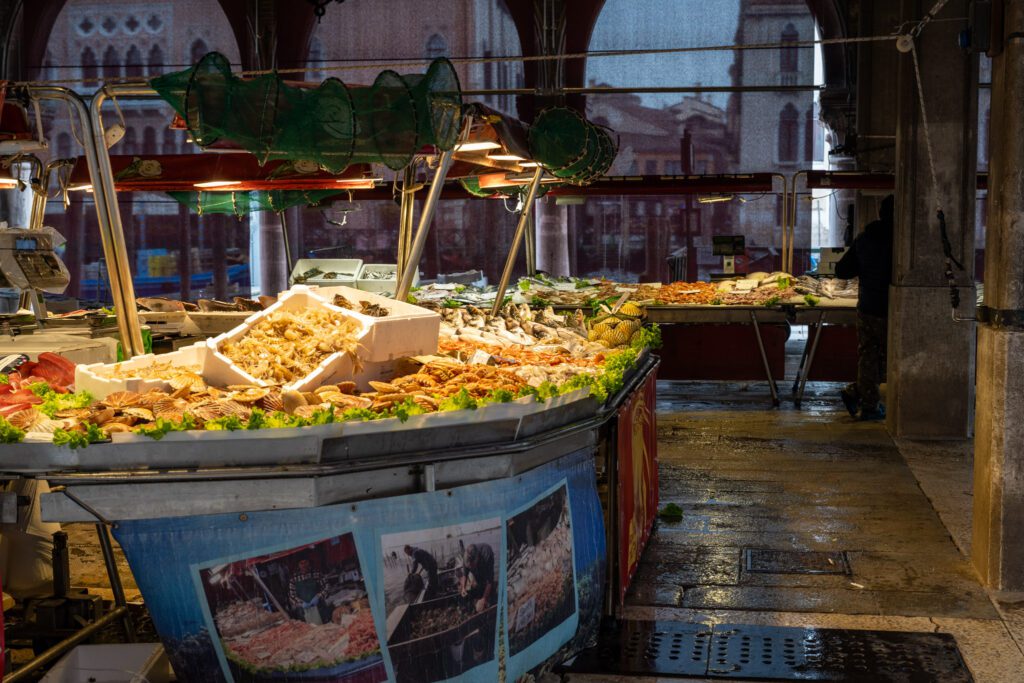
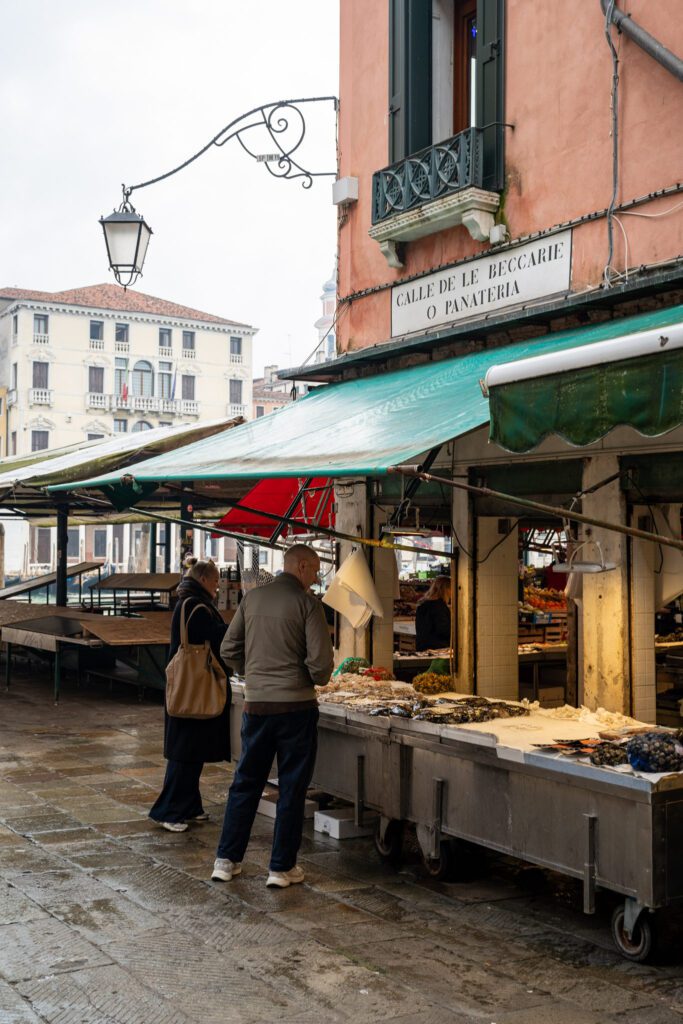
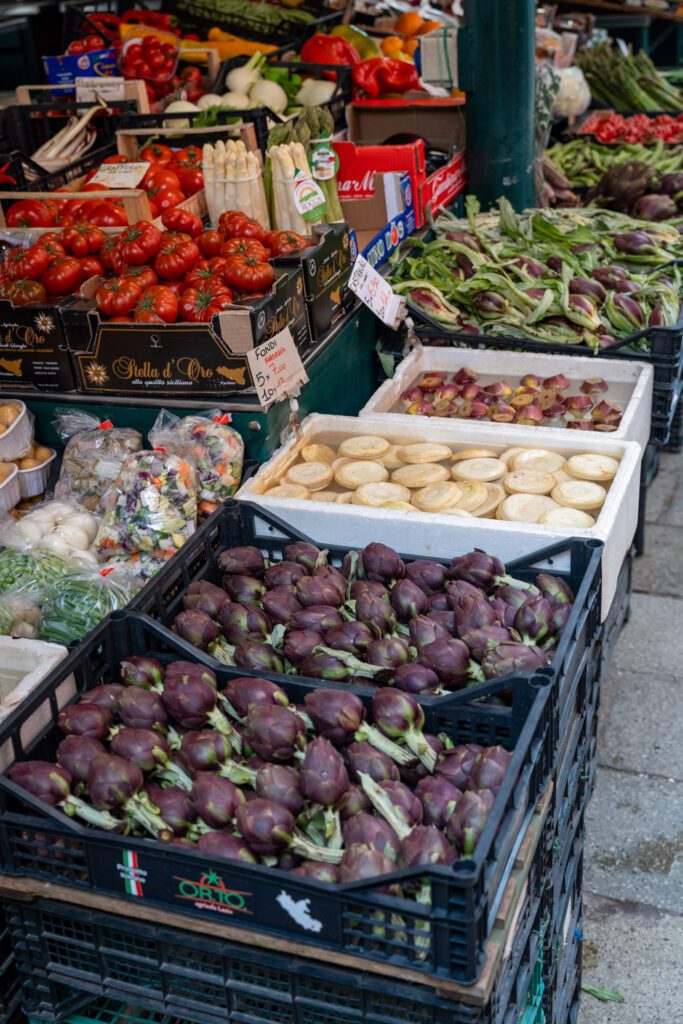
Once you’ve seen the bridge and the market, which are two of the busiest spots in the city and are teeming with visitors, we’d make your way southwest through the rest of San Polo, where you’ll find more charm and more Italian being spoken the further southwest you go.
Here are some stops we’d make sure to make along the way, and here’s a map of that route that puts together all of the stops we recommend.
- Caffè del Doge: Located on a quiet side street half a block from the Grand Canal near Rialto Bridge, this was my favorite place to grab coffee in Venice. Very friendly staff – even with my shoddy Italian – and the coffee is rich and chocolatey, which is what I’m craving when I go for espresso in Italy. Mostly locals here, which was surprising to me given the location.
- Ponte Bernardo: Of all the beautiful canal pictures I took in Venice, this was my favorite. Mostly because it’s relatively quiet, and there’s a nice view of the tower of the Frari Church down the canal to the southwest. You can find it here on Google Maps.
- Campo San Polo: One of my favorite squares in the city, lots of activity here at all times of day. In the morning, people with their dogs mill around in the center of the square. In the afternoon and evening, people walk through the square or enjoy a spritz at the tables for the restaurants on the southeastern side of the square. It’s here on Google Maps.
- Basilica di Santa Maria Gloriosa dei Frari: My second favorite church in Venice, I would say it is definitely worth the cost of entry. It’s a massive brick building that seemingly comes out of nowhere if you’re approaching it from the east, when you’ll turn a corner, cross a bridge, and BAM there’s a huge brick basilica. Some good sculptures and art on display by Donatello and Titian, and more. The structure itself is also impressive, and I really enjoyed spending 30 minutes walking through and seeing the art, tombs, and soaring ceiling.
Dorsoduro: The Young & Hip Part of Venice
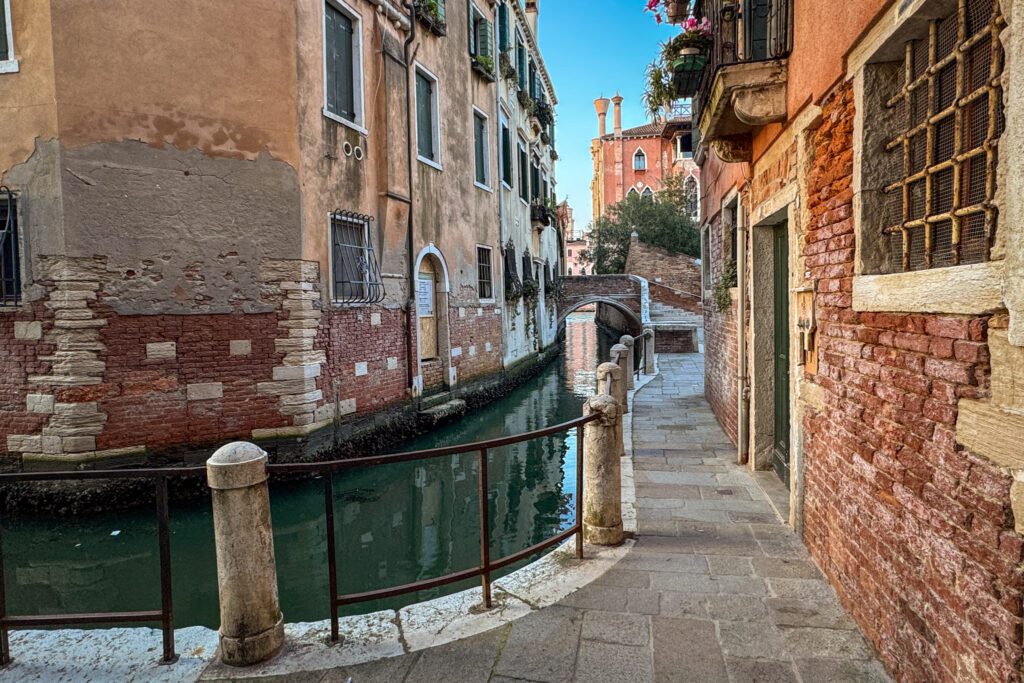
Dorsoduro is the coolest part of the city (I think).
It’s charming, lively in parts and quiet in others, and has one of the better cicchetti scenes in the city, with tons of bacari lining the side canals with people standing outside with a spritz and a cicchetti in the afternoon.
The beating heart of the neighborhood is the university – the Università Ca’ Foscari – which is at the northern edge of the neighborhood adjacent to San Polo.
If you walk through during school hours, it’s a steady stream of people who will have you questioning whether students have gotten younger, or you’re just getting older.
The connection point to San Marco – the Ponte dell’Accademia – is worth visiting in the later afternoon too. It’s a beautiful wooden bridge that is full of people watching the boats pass underneath along the Grand Canal as the sun dips.

We’d recommend an afternoon walk through Dorsoduro that features one of the two museums and a visit to the basilica broken up by some drinks and snacks.
Which museum you opt for between the Accademia and the Peggy Guggenheim Collection depends mostly on your interests (classic art vs. modern art).
We’re going to give you some stops we’d recommend from west to east, but if you’re coming from San Marco, you can reverse the stops.
Here’s a map of the main stops we’ve recommended below that will give you an idea of how to piece it all together.
Campo Santa Margherita: A fitting place to start your journey because the liveliness here is emblematic of the rest of the neighborhood, with a significantly younger vibe than most of Venice.
There are a bunch of places to eat and drink lining the square, and on nice days the middle is full of tables of people enjoying their coffee or spritz in the sun. Find it here on Google Maps.
Campo San Barnaba: Another great campo just a short walk from the last one. I ended up here multiple times because of the fact that there’s a Grom location, which is my favorite gluten free gelato in Venice.
I like the view of the campo from the other side of the small canal right before you cross the bridge from north to south. It’s here on Google Maps.
If you want to make this your first stop for food and drinks, I walked by both Osteria Ai Pugni (here on Google Maps) and Bacaro dai Fioi (here on Google Maps), and they were two places that I saved on my map as particularly popular.
The Gallerie dell’Accademia: The best art museum in Venice if you’re interested in Venetian masters like Tintoretto and Titian and their bright colors and lifelike depictions of fabrics (I love the focus on the texture of the fabrics they are depicting).
It’s a relatively small museum as art museums in Italy go, and it will take you somewhere around two hours to see it all.
They have a nice option called “arteritivo” for people 26-35 years old that is valid Fridays from 5:15pm to 7pm, which is a nice option for this particular itinerary. No need to buy tickets in advance here.
The Collezione Peggy Guggenheim: This is a modern art museum, which are a little hit or miss for us (especially without a guide to help us interpret them).
It’s very popular, and features art from famed modern art stars like Jackson Pollock, Picasso, and Dalí (among many others). You should buy tickets in advance for this one, because it’s popular and does sell out.
Rio di San Trovaso: With your museum stop complete, it’s time to eat and drink!
This particular stretch (starting here on Google Maps and running south to the end of the city) was recommended to me and I’ve seen it featured in “where to eat” guides, and it’s a great place to grab a spritz or glass of wine, a couple of cicchetti to sample, and move on to the next place that looks interesting.
The spot that always gets recommended (by food people I trust) is Osteria Al Squero, and you’ll likely see a big crowd of people out front with plastic glasses of wine and small plates piled with cicchetti.
Cantine del Vino già Schiavi is a place that I stopped for a glass of wine, and I was JEALOUS of the cicchetti that people standing next to me (there are no seats – standing room only, which is fun!) were eating.
From there, round the corner and walk along the water, which is the southern edge of the historic city.
The Basilica Santa Maria della Salute: Depending on the time of day you’re here, it might be closed to entry. But the cupola of the church here – which was built in the 16th Century to commemorate the survival of the city after a particularly bad plague – has an excellent view of the city. You’ll also find frescoes by Titian and Tintoretto in the sacristy.
Entry is free, but the cupola (€8) and sacristy (€3) come with a cost. If you’re doing the museums and one of the bell towers in Venice, we’d skip it.
Cannaregio: Finding the Quiet Corners of Venice
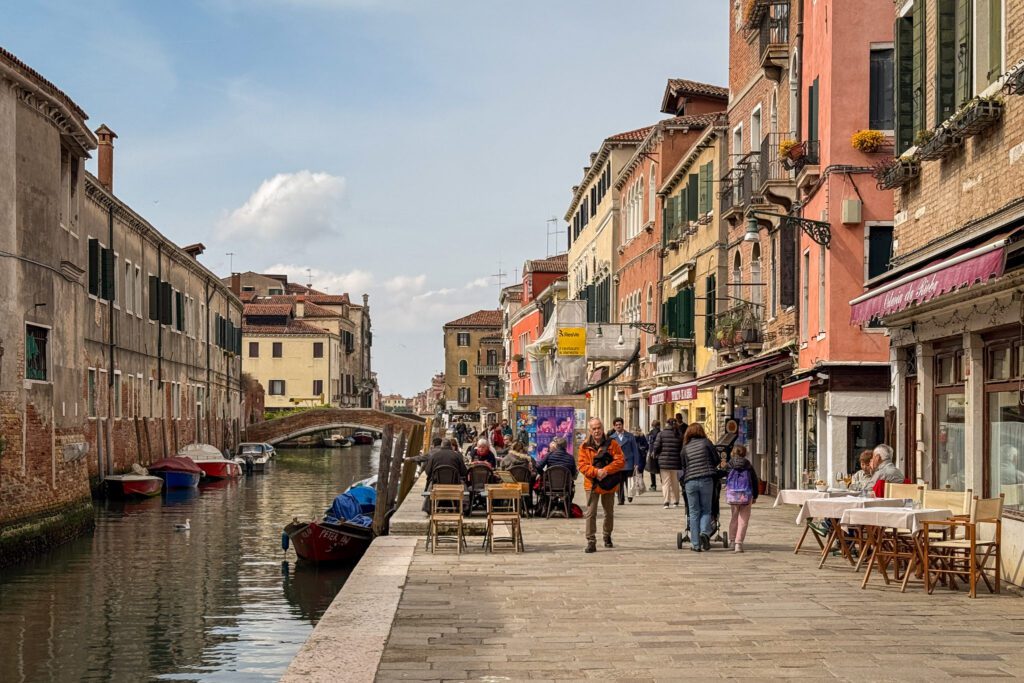
This is the part of the city where I was wandering around 2pm on a weekday and realizing that there really are multiple sides to Venice, and most visitors only get a chance to see one side on their trip.
Generally speaking, the further north you go (and thus the further from Piazza San Marco), the more interesting things get.
We’d pair Cannaregio with the islands of Murano and Burano (more on them in a second) because as you’re coming back from the islands, you’ll be arriving at Fondamente Nove, which is basically the northeast corner of the neighborhood.
We’d start there and make your way southwest, ending at the train station.
Here are some stops we’d make along the way, which form a nice little promenade through Cannaregio (here’s a map linking them all together).
Basilica dei Santi Giovanni e Paolo: My third favorite church in Venice, it’s more austere than the other two, but is worth poking your head in to see the final resting place of 25 Venetian Doges and the soaring ceiling done by Veronese (along with a bunch of other beautiful art).
The square it’s on is also really nice, and full of people sipping either coffee or spritzes, depending on the time of day. Very lively, very fun!
Campo Santi Apostoli: The most lively square I saw in Venice with lots of al fresco bars and restaurants, street performers, and nonnas sitting on the benches soaking up the sun.
Fondamenta de la Misericordia: My single favorite stretch of the city, this canalside walkway is full of places to eat and drink, and is a great place to have cicchetti and a spritz or three.
Vino Vero was recommended to me by two different Venetians when I asked where to eat and drink in the city.
There are truly an endless number of places to eat here, and I’d follow it to Ponte de Gheto Novo (here on Google Maps), the entry point to one of the three former Jewish ghettos in Venice.
The Gheto Novo: Similar to many places in Europe, at one point, Venice has a complicated, less-than-savory history when it comes to its Jewish inhabitants.
At one point, they were welcomed. Then they were forced to live in specific areas (there are three former Jewish ghettos in Venice, all in this general vicinity, and they are the oldest in the world) and then they were expelled completely to the mainland as the Catholic Church began to flex its muscles and exert power over Venice.
It’s a sad story, and if that’s something you’re interested in learning about I highly recommend Lucia’s walking tour focused on Jewish history in Venice, which I did and loved.
Otherwise, walk through the area to the other entry gate (here on Google Maps), which was one of the main gates to enter the ghetto, stopping at the Museo Ebraico di Venezia (closed for renovations when I was there) for a guided tour and a lesson in Venice’s Jewish history and a visit to the synagogue upstairs.
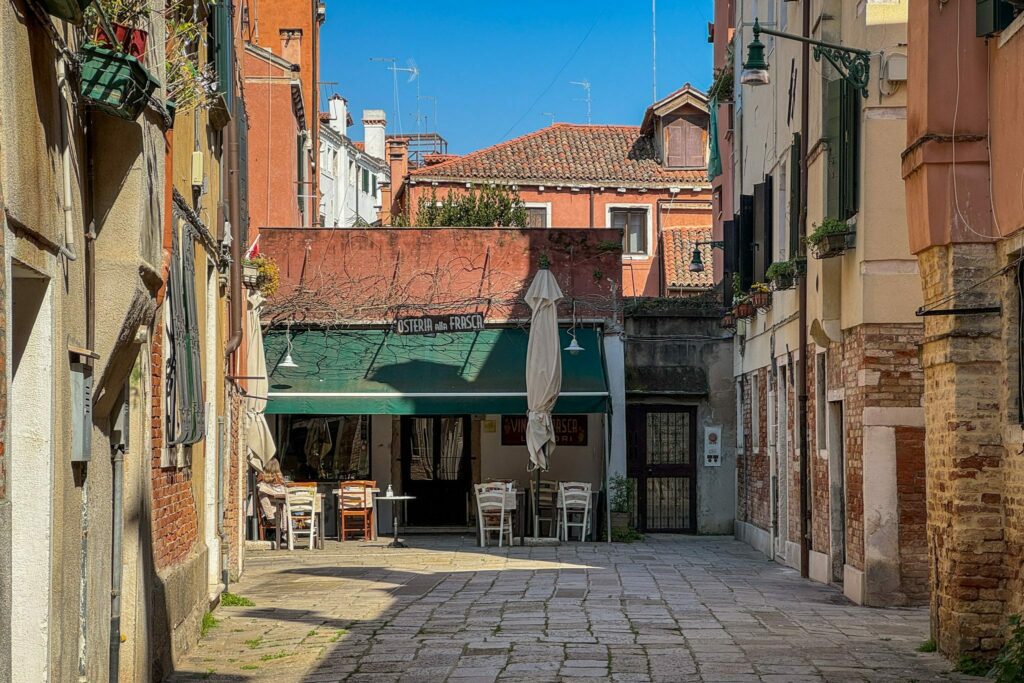
Take a Walking Tour to Get a Local’s Perspective
Walking tours are our favorite way to get oriented in a new city for a few reasons.
First, you get a crash course in history and culture, which is a valuable baseline that will make the rest of your trip more enjoyable.
Second, you get to spend a few hours with a local who will give you all sorts of tips about what to eat, drink (and see), and specifically where to find the best version of said things.
Last, but not least you’ll discover places that you definitely would never have found on your own.
We always do a walking tour on our first day in a city, and Venice was (supposed to be) no different.
I chose this walking tour but, unfortunately, they cancelled on the morning of the tour and the timing didn’t work for a different day.
So while I can’t speak to how the tour actually is, I can tell you that I liked the concept enough to book it for myself.
It’s also worth noting that I did a tour covering the Jewish history of Venice with Lucia (this one), who also has an introductory walking tour that I would recommend mostly because Lucia, a Venetian, is a great storyteller and full of great recommendations that will inform the rest of your trip.
Take a Trip Out to the Islands (Murano and Burano)
One of the unique aspects of the lagoon that Venice calls home is the fact that there are a bunch of small islands dotting it outside of the historic city center.
They even grow all sorts of things out on the lagoon, including artichokes and grapes, which was something I didn’t know until this latest trip in the spring in the heart of artichoke season.
Of the many options, the two islands we think you should focus on are Murano and Burano.
Murano is the closer of the two, and is also most well known and most visited.
It is known for its glass (Murano glass), and is a great place to pick up gifts to bring home and visit workshops and showrooms full of colorful pieces that are made in the lagoon.
Burano is a little further out – around 45 minutes from the vaporetto stop in Cannaregio to the island – and is known for its lace. The higher barrier to entry in terms of time means that it sees far fewer visitors, though it is equally as beautiful as Murano.
We’d spend the morning – the time of day is important, because they get CROWDED the later into the afternoon you get – heading out to one of the islands.
Choose the island based on your interests and stay there through lunch.
You could, theoretically, do both, but it will take the better part of the day and you may have to move things around to fit them.
We’d say that, with three days, we’d choose one to focus on to maximize your time in Venice itself (and with anything less than three days, we’d skip them altogether).
However, if you do absolutely have to see both, we’d head out early (like, leave Venice at 8-9am early) to beat most of the crowds out to Burano first, then hit Murano on the way back towards Venice.
If you find yourself with more time (more than four days), then it makes sense to add another island, maybe even two (Torcello has the oldest church in Venice and sees far fewer tourists than the other two – it’s a significant vibe shift with more greenery).
If you’re going to do them all in one day, we’d do it in this order; Burano, Torcello, Murano.
The reason is that Burano is much more pleasant before the crowds arrive, and the serenity of the small island is a lot lower when it’s packed full of people.
Option 1: Murano
Murano is the significantly easier trip of the two. It takes about ten minutes to get from the vaporetto stop at Fondamente Nove (here on Google Maps) out to the stop on the southern tip of the island.
It’s also a pretty big area, with multiple smaller islands to explore including a big park at the northern end.
There are a couple of things we’d focus on for your morning out on Murano; the glass, a walk, and the two churches (more on them in a second).
Let’s start with the glass, which is the most enticing part of Murano. Unfortunately, the reality is that the industry is not doing great, and the traditional art of glassmaking has mostly died out (especially as younger generations see the rising cost of living and realize that the math of being an artisan isn’t working).
However, there are a couple of places where you can see the artisans in action, and which you choose kind of depends on what kind of experience you’re looking for.
At the most basic level, you have the glassblowing demonstration at the Glass Cathedral, which is in a renovated church and is about as bare bones as it gets in terms of explanations and interaction with the visitors.
It’s one of the most popular (it’s right off of the vaporetto) and they have a demonstration every 45 minutes all day long, which means a lot of people come through here.
For a more in-depth and personal tour that will give you more insight into the techniques and processes they use to make Murano glass, this small group tour is a better option because it’s at a factory that sees far fewer visitors and you’ll get more explanation of what exactly you’re seeing.
Finally, if part of your vision includes actually making some glass, that same factory does a glassmaking experience that will take you even deeper and have you actually making something to take home with you. It’s expensive, but it’s about as experiential as you can get and on par price-wise with doing a similar experience at home in the US.
The two churches are the Duomo Basilica dei Santi Maria e Donato, which is the more impressive of the two with its brick facade and gorgeous Byzantine mosaic floors (it costs €3.50 to visit, cash only), and the Chiesa di San Pietro Martire (Church of St. Peter the Martyr), which has some nice works by Tintoretto and Pablo Veronese, two of Venice’s most famous artists and is free to visit.
The Duomo is also known for (allegedly) housing the bones of the dragon slain by St. Donatus, which is…kind of funny.
They’re relatively close to each other, so if old churches with art from centuries ago are something you’re into, it’s worth visiting both.
In terms of a walk, we’d do a nice little loop that starts and ends at the vaporetto, cross over Ponte Longo Lino Toffolo to the middle island (and over to the first church, if you’re interested), and then back to the vaporetto stop. Something like this.
Option 2: Burano
If we’re being honest, we’d probably just skip Burano with limited time because, yes, the colorful houses are beautiful, but it’s also a big time investment (an hour and a half on the boat there and back) if you have a relatively short time in Venice.
However, a lot of people see the pictures of the colorful buildings and they want to see them with their own eyes. If that’s you, here’s how to make the most of it.
Burano has a lot less going on in terms of things to do (the population is less than 3,000), but is arguably more beautiful with its colorful houses and canals.
You’ve almost certainly seen pictures of the photogenic colorful buildings (which some people think are in Venice itself, but are actually on an island 45 minutes away).
Burano is harder to get to – the water bus ride is closer to 45 minutes (and it stops in Murano, which is how you’d combine them if you wanted to do both) – but that also means you’ll find fewer people making the journey (though it should be noted that “fewer” does not mean that you’ll be the only visitor).
The island is in a little bit of a tough spot these days for many of the same reasons that smaller Italian towns (and American, and Canadian – it’s a universal problem) are seeing shrinking populations.
Younger generations are seeing the rising cost of living along with fewer job opportunities outside of urban centers and opting to relocate to cities like Milan rather than stay.
However, it’s also true that Burano is a little less “Disneyland-ified” than Murano, and the result is a more dynamic food scene.
Our advice here would be to take an early vaporetto, arrive, grab a coffee and a pastry for breakfast, and wander around a bit.
Eventually, you’ll want to end up at the Lace Museum (Museo del Merletto) to learn about the art of making lace, which has been a hallmark of Burano for centuries.
After that, finish circumnavigating the island, stop at Chiesa di San Martino to see the leaning bell tower, and find a place to have lunch before catching the vaporetto back to Venice for the afternoon. Burano is, at its core, a fishing village, and you’re going to get seafood that is as fresh as it gets on the island.
If you want fresh seafood, Trattoria al Gatto Nero is a spot that was recommended to me by someone in Venice.
If you’re up for a longer walk (Burano is tiny, so you’re not going to need much time to circumnavigate it), you can extend your walk by crossing the footbridge over to Isola Mazzorbo, an island known for its vineyards (an unexpected thing to find in a lagoon).
Head to San Giorgio Maggiore’s Bell Tower

I didn’t get a chance to do this myself, but the view from the bell tower at San Giorgio Maggiore – an abbey out in the middle of the lagoon that you’ll have to take a boat to – is supposed to be one of the greatest views of the city.
To get there, you can take the 2 from the Grand Canal just east of Piazza San Marco (from San Zaccaria), and it’s a quick, one stop ride to the island. It’s free to enter the church, but it costs €8 to get up to the bell tower for the view (there’s an elevator).
Check out the details on the official website and buy tickets on arrival (it’s not a huge draw for tourists, so lines aren’t that long).
Take a Day Trip to Verona
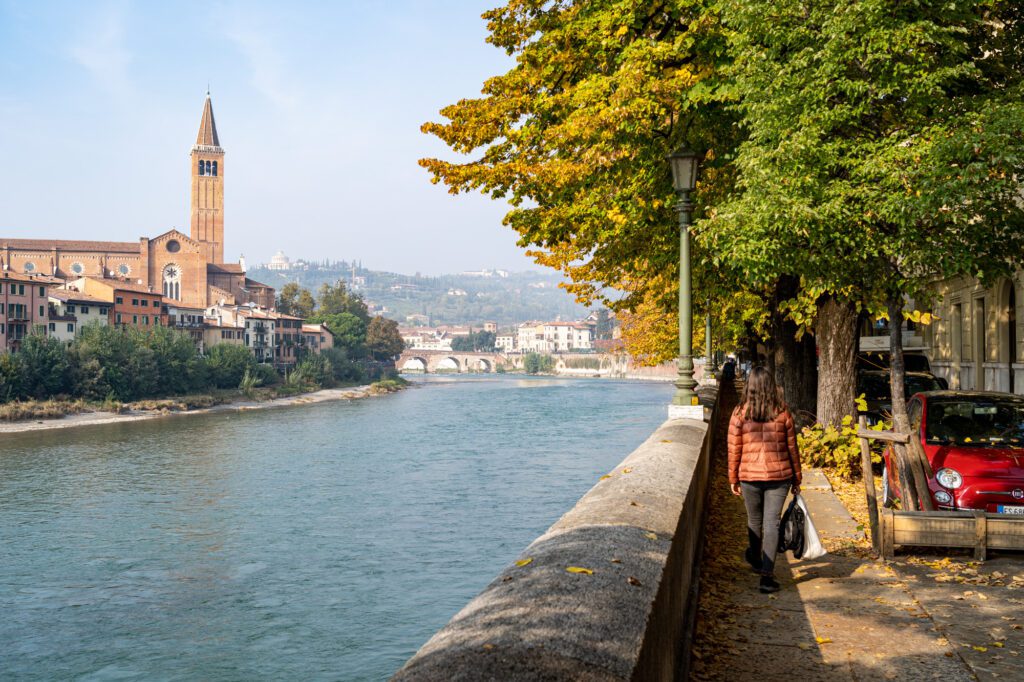
If you have an extra day in Venice and you’re looking for a different side of northern Italy, we can’t recommend Verona more highly.
It was one of our favorite discoveries on our six week Italian adventure a few years ago, and we’ve been talking about returning ever since.
Verona is a beautiful riverfront city that we absolutely love (as long as you skip Juliet’s House, which is the worst tourist attraction we’ve ever personally done).
There’s a huge Roman arena, several excellent viewpoints, a couple of nice churches, and a museum or two that are worth your time. Overall, a very enjoyable place, and we ended up spending three days there a few years ago.
Best of all, it’s a quick and easy hour and fifteen minute high speed train ride from Venice (book in advance for cheaper fares).
More on what to do and see in our guide to spending a day in Verona.
Things to Do for Foodies in Venice
I can’t tell you how many times I have heard some version of “the food in Venice sucks.”
And, if we’re being honest, I have said that exact thing myself about the gluten free food scene in Venice when compared to other cities in Italy.
However, as soon as you start to ask questions and dig one layer deeper, you realize that the person who uttered that phrase ate pizza and lasagna (two very un-Venetian things that you’ll likely only get at restaurants geared towards tourists) or, like me, isn’t jazzed about seafood.
While I wouldn’t use “bad” to describe the food scene in Venice, one word I would use is “different.”
And as we like to say, different does not mean worse or bad (and different is generally a good thing to experience – it’s part of why we believe in the transformative power of travel).
Again, a big part of the reason we enjoy Italy is the regional diversity that you find moving around the country, and the Venetian food scene (really, all things Venice) is a beautiful encapsulation of that idea.
In this section, we’d like to give you as much information as we can about Venice’s food culture to help you NOT be one of the people who says that the food in Venice sucks.
What to Eat in Venice
I want to start this section about food in Venice by saying that I have a somewhat unique (another word might be useless) perspective on the food scene in Venice for two reasons.
First, I have Celiac Disease, and while Italy is generally a great country to visit if you need to eat gluten free, Venice is constrained by both geography and cost, so the gluten free food scene is mediocre (you can read about it in my gluten free guide to Venice).
An added implication of my inability to digest gluten is the fact that it makes it very hard for me to experience what I think is the most unique aspect of Venice’s food culture, the cicchetti (which are like little bite-sized appetizers served alongside spritzes before dinner – like aperitivo, but with a Venetian flair).
Second, I’m not a huge seafood person, so the non-cicchetti part of Venetian cuisine – which as you might expect revolves around seafood thanks to its location – isn’t particularly appealing to me either.
That being said, I had three seafood dishes on my list to try while I was in Venice, and I did try all of them made safely gluten free, which I was excited about.
For those reasons, I’m not really the right person to give you specific advice on where to eat in Venice.
Instead, I’m going to make sure to link out to people who have a more informed (another word might be useful) perspective that I trust and think you should listen to about what to eat in Venice, and where to eat it. More on that in a second.
As I mentioned, in my mind, there are two parts of Venice’s food scene. And while you’re in Venice, you should probably try to experience both.
The first is the seafood focused part, which tends to be what you find at sit down restaurants in Venice.
Before my trip, I was doing some reading about what to eat in Venice to create my list (which I would then try to find made safely gluten free), and there were three dishes in particular that stood out to me.
- Sarde in Saor: Fried sardines mixed with soft onions in a sour sauce (which is vinegar-based, with a hint of added sweetener). I’m always hesitant to order sardines, partially because I never know where the “don’t eat the bones” cut off is in terms of how big the fish are. Worth trying for sure, but I don’t know if I’d order them again.
- Spaghetti alla Busara: Pasta with a slightly spicy red sauce and some sort of squid or cuttlefish? This is my ideal version of seafood, I think (read: drenched in sauce) and it did not disappoint.
- Seppie al Nero: The most interesting of the bunch, I was so perplexed by the flavor of the black sauce that is the star of this show that I had a five minute impromptu conversation with the server and then one of the chefs (half in broken Italian, the other half in broken English) about how to make the sauce. Turns out, it’s basically a sofrito (onion, garlic, tomato stir fry) with the squid ink – the thing that gives it the black color – added near the very end (if you add it too early, it gets bitter). Seppie are a type of cuttlefish that are plentiful in the lagoon, and it’s traditionally served with polenta, one of the grains of choice in northern Italy (versus wheat-based pasta in central and southern Italy).
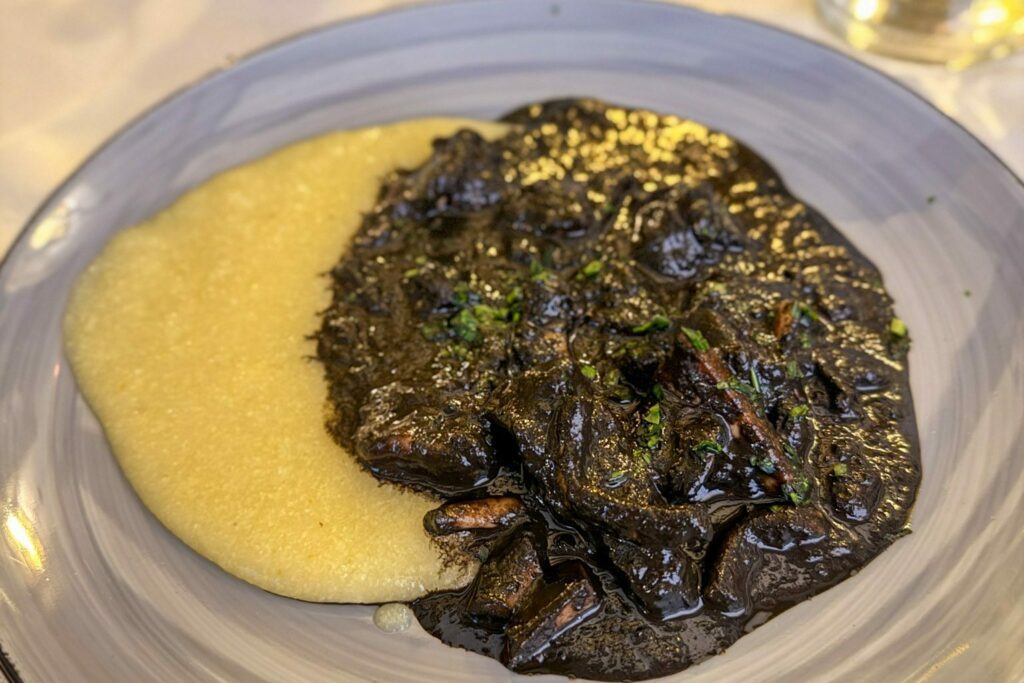
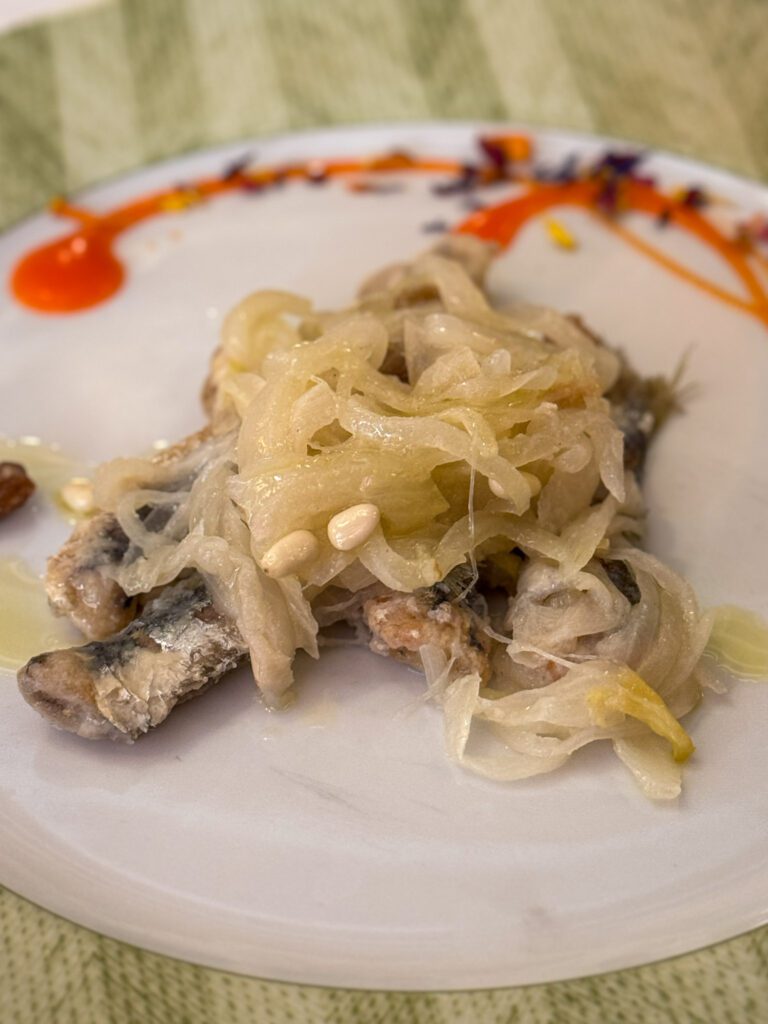
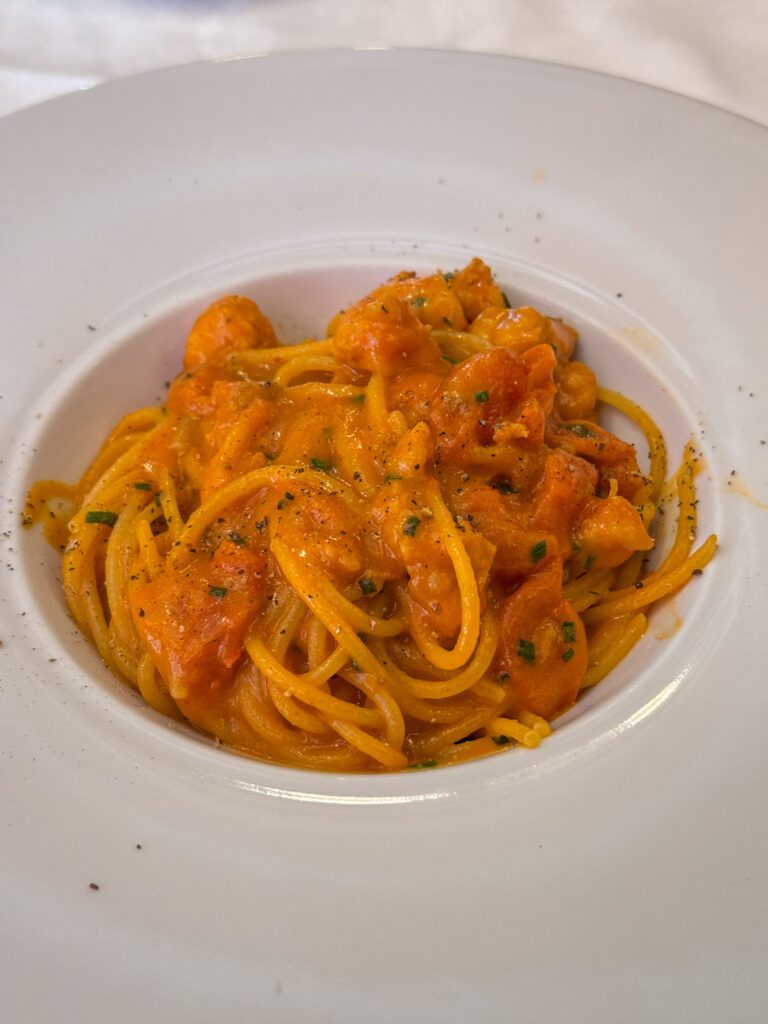
Though, of course, you can find all sorts of grilled fish of the day and fried squid on menus across the city. Venice is an excellent place to indulge in fresh seafood.
The second is the cichetti, which are mostly consumed in the afternoon (between lunch and dinner) and come in several forms, kind of like tapas and pintxos in Spain.
Sometimes, it’s a bite-sized portion of a dish that would usually be served in a bigger format, other times it’s basically a slice of bread topped with some sort of cheese, meat, or seafood.
They’re meant to be eaten in one bite, maybe two, and are usually consumed alongside either a glass of wine or a spritz – a delightful combination of bitter liqueur, sparkling wine, and sparkling water.
When it comes to the liqueurs involved, they’re a balance between sweet and bitter.
Orange-hued Aperol is the one you see most often and is the sweetest, while red-hued Campari leans more bitter, and local’s favorite Select is somewhere in between.
For specifics on where to eat while you’re in town (and more on the food culture in Venice), I’d point you towards this guide to Venice’s food scene (mostly focused on cicchetti) and this guide from Valeria, who is a Venice local and has literally written a book on the food scene in Veneto.
Take a Food Tour
Diving into the food culture in places we’re visiting is one of our favorite aspects of traveling, and we try to include a food tour, cooking class, or market tour in most places we visit.
Seeing a place through the food that they eat offers a different perspective, similar to the idea of seeing Venice from the water.
Our bias is to do a cooking class, because we LOVE to cook, but we also enjoy a good food tour.
Unfortunately, the reality is that because Matt has Celiac Disease and can’t have even a speck of gluten without being sick for days, a food tour or cooking class wasn’t in the cards for us.
HOWEVER. That does NOT mean it shouldn’t be for you!
We’d highly recommend it because it gives you a local’s perspective on the city’s food scene – what and where to eat and drink – and you get to connect with fellow travelers and try some amazing food.
Here are some options for you that we’ve gone through and selected out of the many food tours available in Venice.
A Venetian Evening – Wine Tasting & Cicchetti: A journey through Dorsoduro, the neighborhood along the southern end of the city (where multiple guides I met in Venice live, which tells you it’s a place where people actually live, versus San Marco) and San Polo and its many bacari. A good balance between walking and eating, with plenty of wine along the way.
Venice Offbeat Food & Drinks Tour: This tour is with a company that my mom (who is not a Celiac) has done multiple food tours with around Europe and has raved about them all. The thing I like about this tour is that it covers tramezzino (a triangular sandwich specific to Venice), cicchetti, and seafood mains – all of the things I think you should try in Venice. This tour is focused on Cannaregio, which is where I was told by multiple people to focus on if you want the best food in Venice (Dorsoduro being the close second).
Venice Bacaro Tour – Eat and Drink like a Venetian: A small group is essential for an enjoyable food tour, and this tour has a max of 10 people, which is perfect. This tour is also focused on a relatively small slice of Cannaregio, and includes at least four stops along the journey. They have an afternoon and evening tour to choose from, which makes it fairly easy to fit into your itinerary.
Get Your Hands Dirty and Take A Cooking Class
We’ve done all sorts of cooking classes around the world (read about our cooking class in Mexico City here), and while the gluten-filled nature of Italian food made it nearly impossible to do one in Venice, that doesn’t mean you shouldn’t.
Cooking classes are a fantastic way to experience the local food culture (especially if there’s a guided market tour involved), meet like-minded travelers, and add a few new recipes to your repertoire at home that will remind you of your time traveling whenever you make them.
Now, Matt has Celiac Disease, which means no gluten for us.
That means that a cooking class in Italy isn’t in the cards – too much flour flying around for Matt to be comfortable and avoid getting sick.
That, however, does not mean you shouldn’t do one.
If we were doing a cooking class in Venice, our number one choice would be this cooking class with a local chef, which includes a visit to the market AND focuses on specifically Venetian recipes (versus generic pastas and lasagna, which we saw several focusing on).
The market tour, in particular, is something we always enjoy because you get so much more out of visiting a market with someone who actually knows the vendors and what the different types of produce/meat/fish are and where they come from than just wandering through alone.
Planning a trip to Italy? We’d love to help!
Here are our other Italy travel guides to help you plan an incredible trip (even if you have to eat gluten free!).
If there’s no link below, it means we’re still working on it – long, in-depth guides take time! We’re working on it, though, we promise.
If you’re planning a trip and you’re not sure where to start, your first stop should probably be one of our detailed itineraries.
We have a two week Italy itinerary that blends the main cities with some less-visited cities that we love (BOLOGNA!), a guide to spending 10 days in Italy that focuses mostly on the highlights, and a whirlwind guide to spending one week in Italy that features the Rome – Florence – Venice highlight circuit.
We also have a guide covering important tips for traveling to Italy for the first time, which is a collection of things we’ve learned over the course of our time in Italy that will help you have a smoother, more immersive trip.
Here are more specific guides to the main cities in Italy.
Rome
- What to do in Rome (as a First Timer)
- How to Plan an Amazing 4 Day Rome Itinerary
- Where to Stay in Rome: A Complete Guide for First Timers
- 26 Things to Know Before You Visit Rome
- Gluten Free Rome: A Complete Guide to GF Restaurants + Bakeries
- Where to Find the Best Specialty Coffee in Rome
Florence
- What to do in Florence (as a First Timer)
- How to Plan an Amazing Florence Itinerary (3 Days)
- Where to Stay in Florence: A Complete Guide for First Timers
- Gluten Free Florence: A Complete Guide to GF Restaurants + Bakeries
- Where to Find the Best Specialty Coffee in Florence (for Coffee Nerds)
- The Best Day Trips from Florence (Complete Planning Guide)
Venice
- A Perfect 3 Day Venice Itinerary (for First Timers)
- Exactly What to Do in Venice (As a First Timer)
- Where to Stay in Venice: A Complete Guide
- Gluten Free Venice: A Complete Guide (for Foodies)
Bologna
- What to do in Bologna (as a First Timer)
- How to Spend One Incredible Day in Bologna
- How to Plan an Amazing Bologna Itinerary (2 Days)
- Where to Stay in Bologna: A Complete Guide for First Timers
Cinque Terre
- What to do in Cinque Terre (as a First Timer)
- How to Plan an Amazing Cinque Terre Itinerary (2 Days)
- Where to Stay in Cinque Terre: A Complete Guide for First Timers
Milan
- What to do in Milan (as a First Timer)
- How to Plan an Amazing Milan Itinerary (2 Days)
- Where to Stay in Milan: A Complete Guide for First Timers
- Gluten Free Milan: A Complete Guide to GF Restaurants + Bakeries
The Rest of Italy
